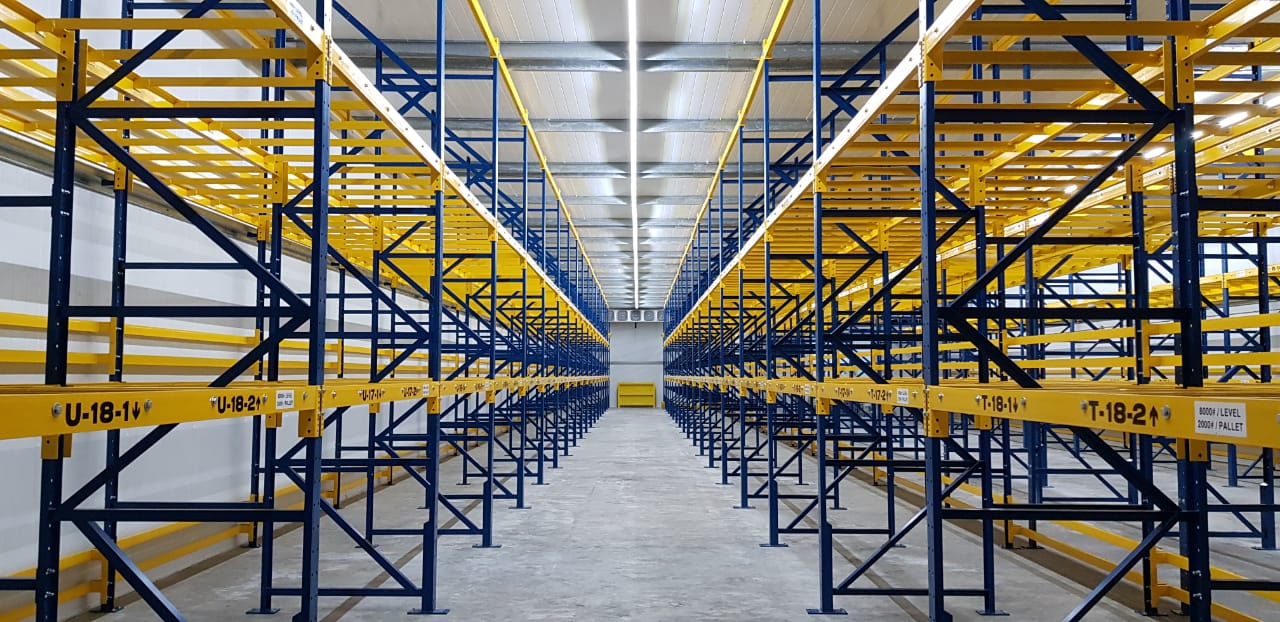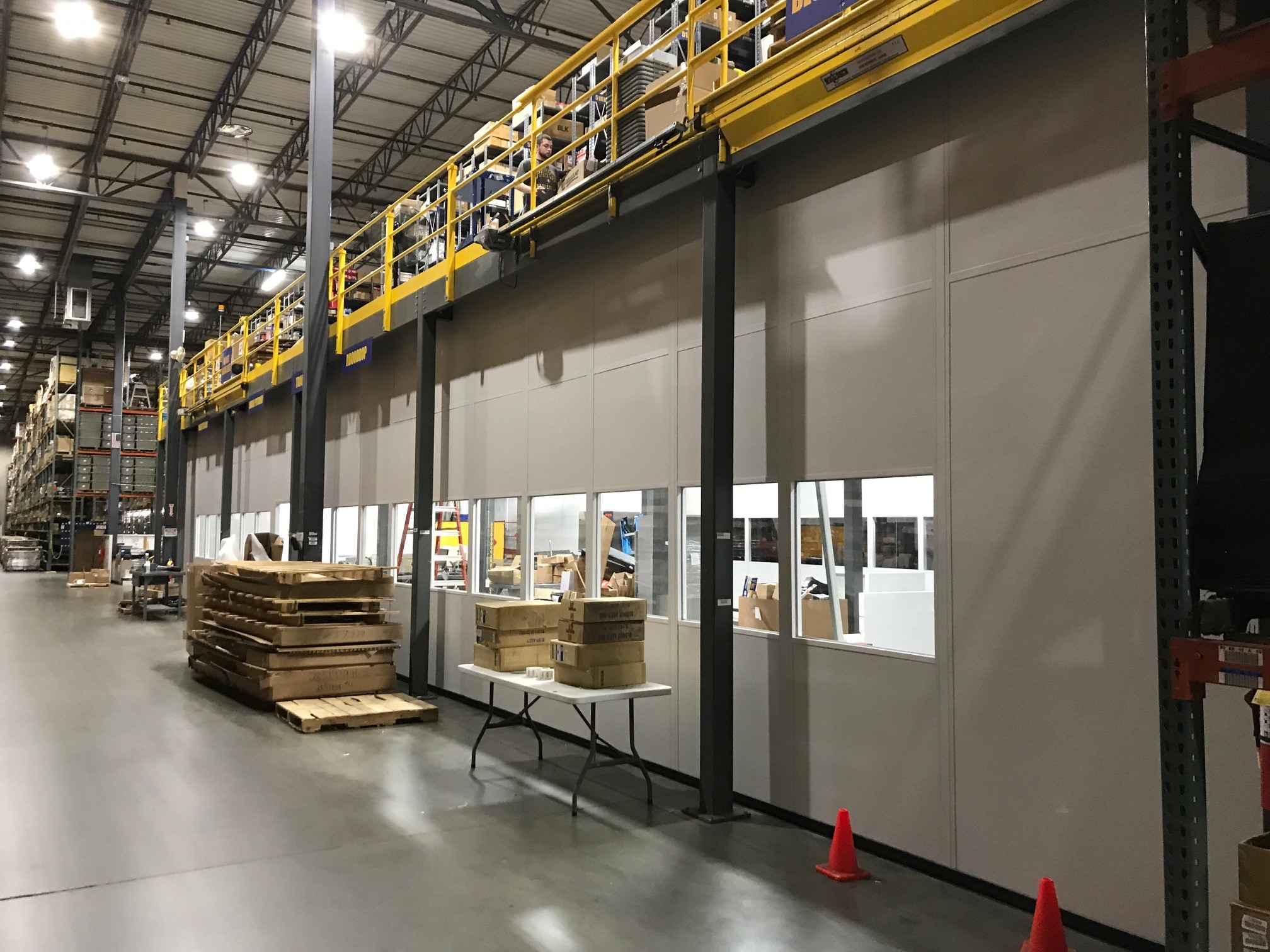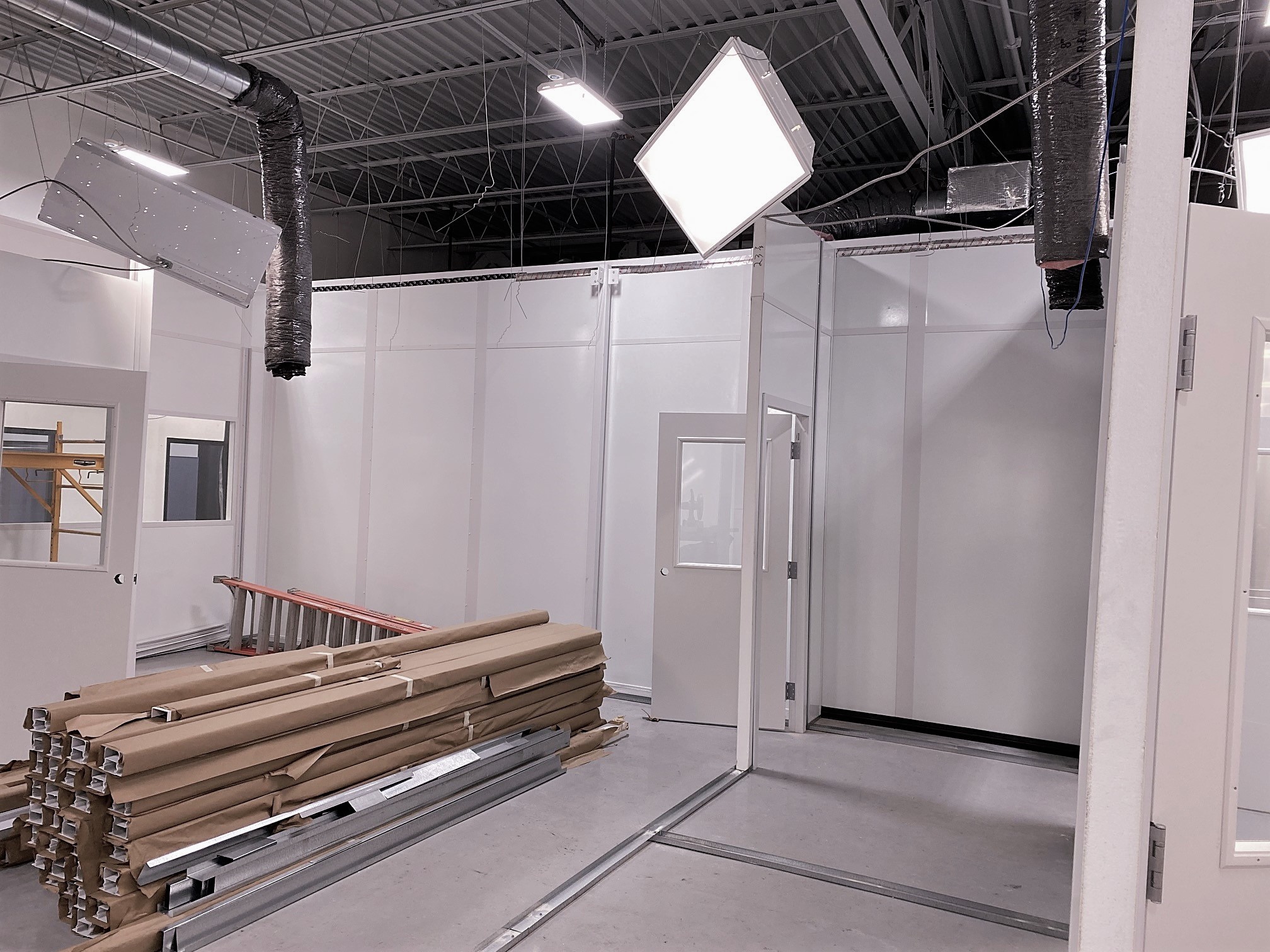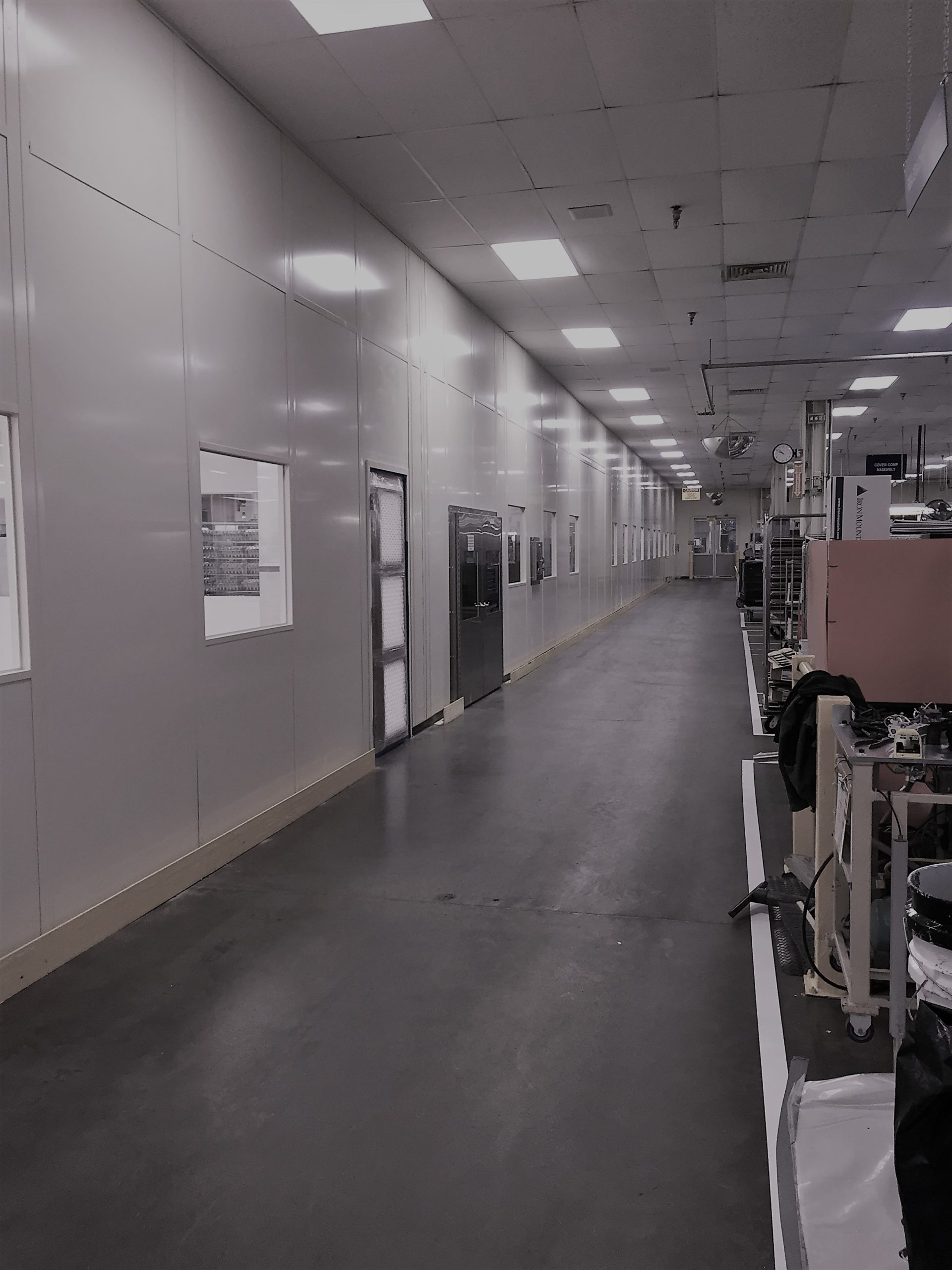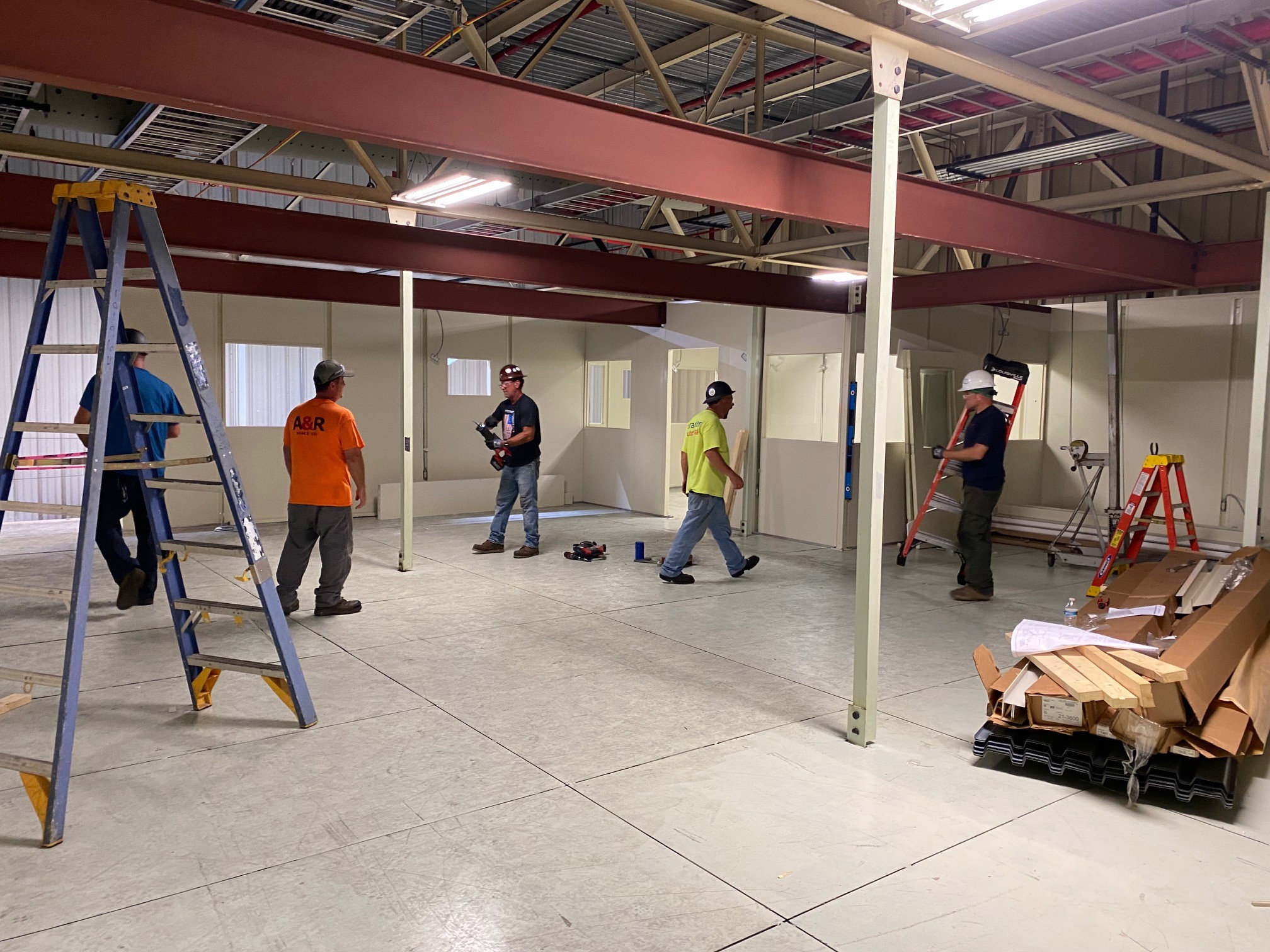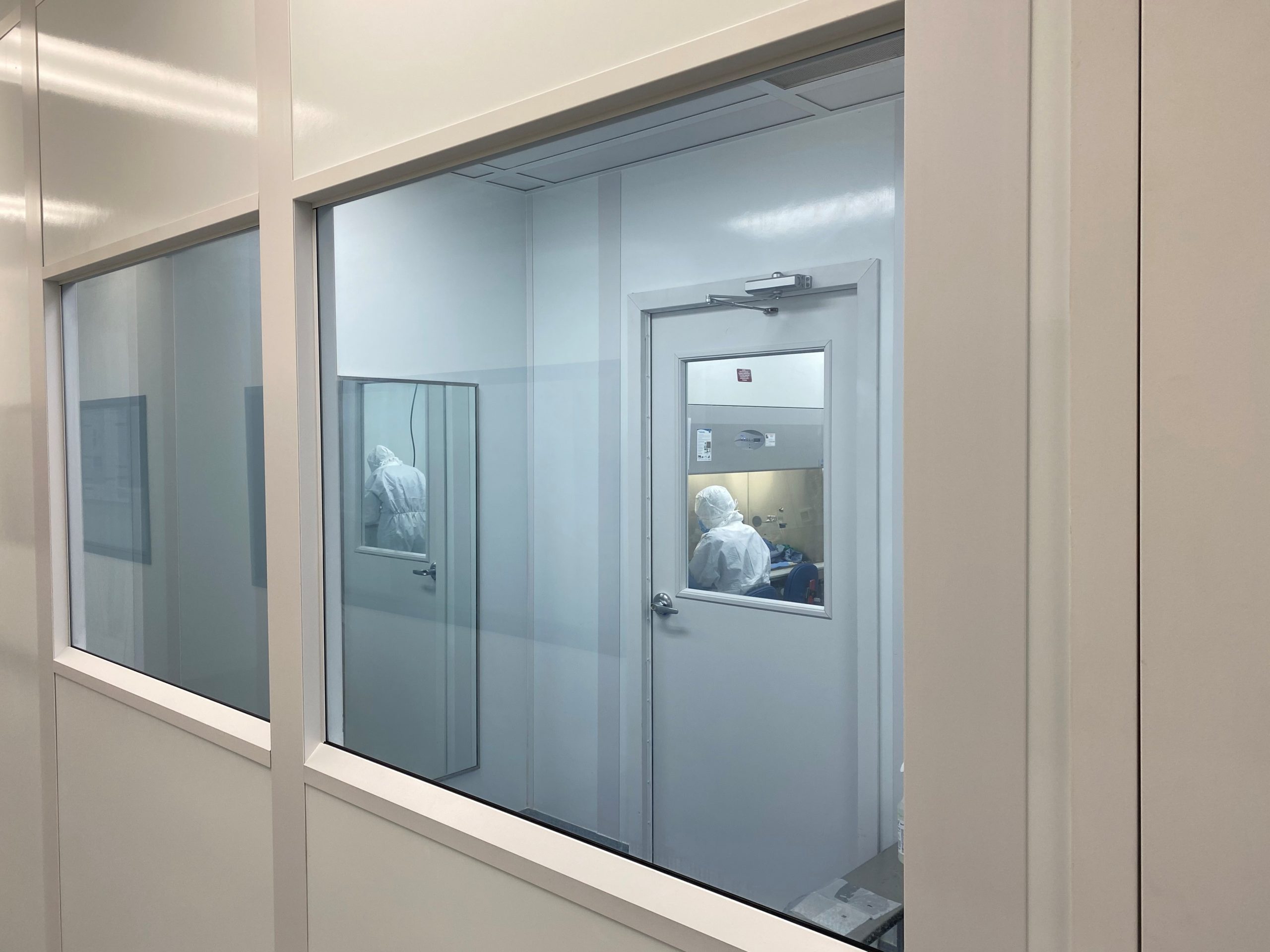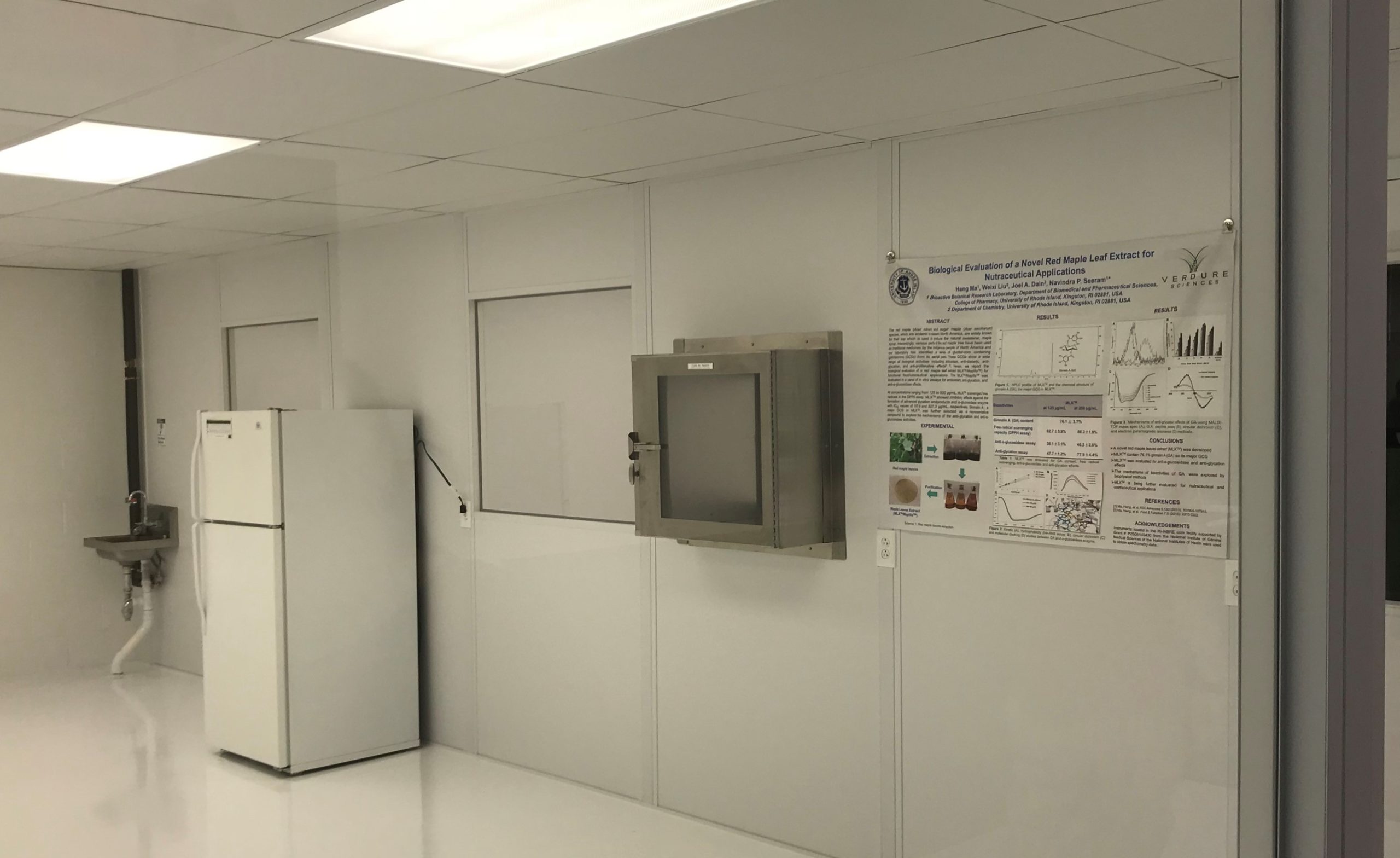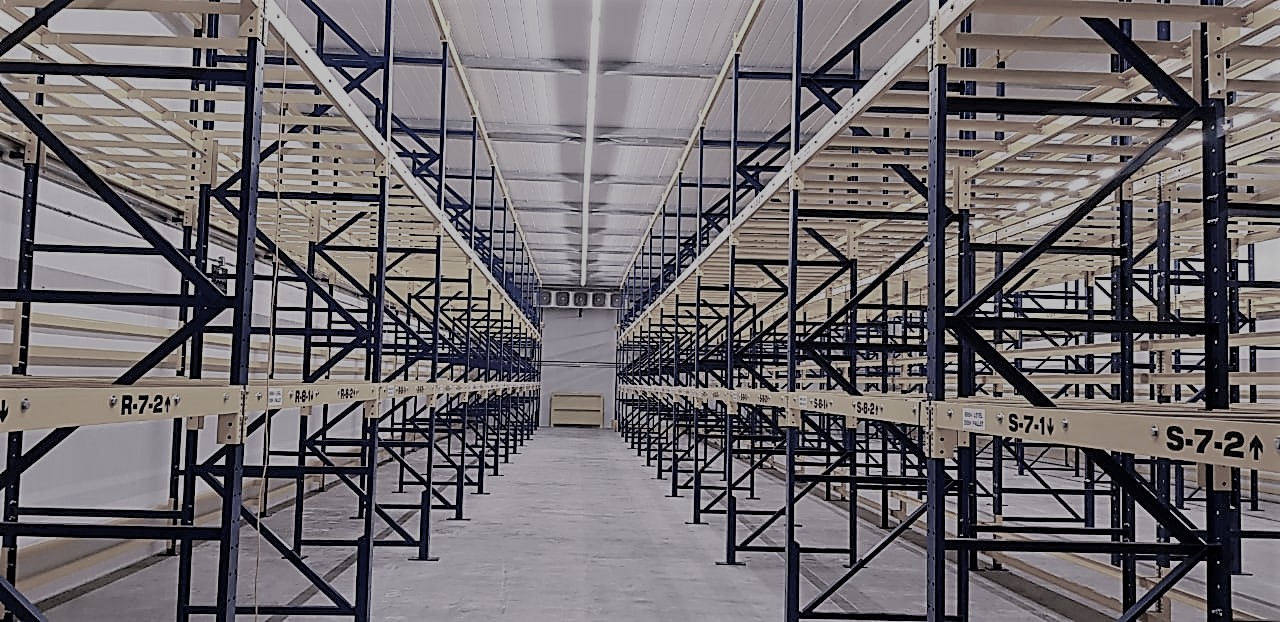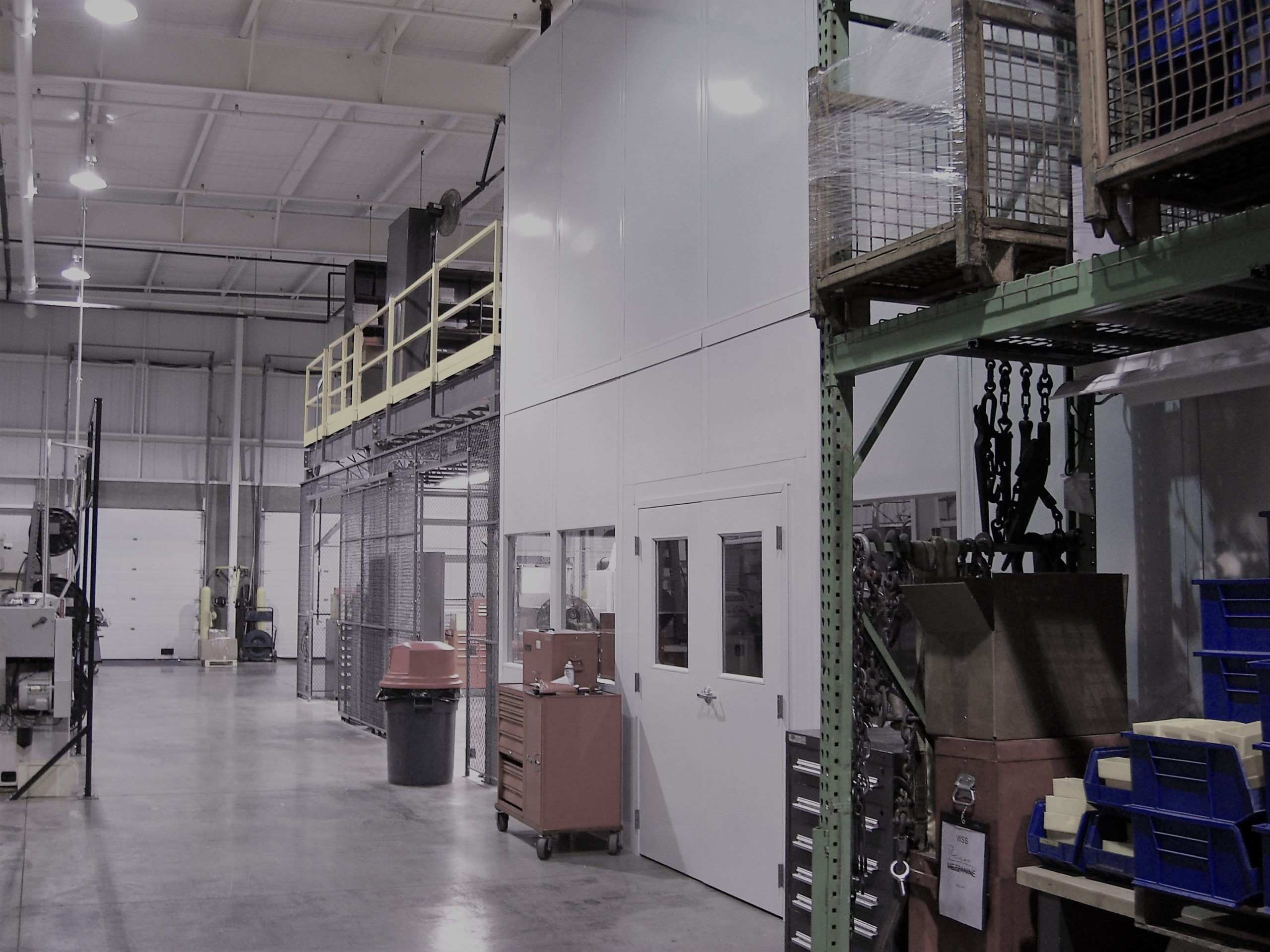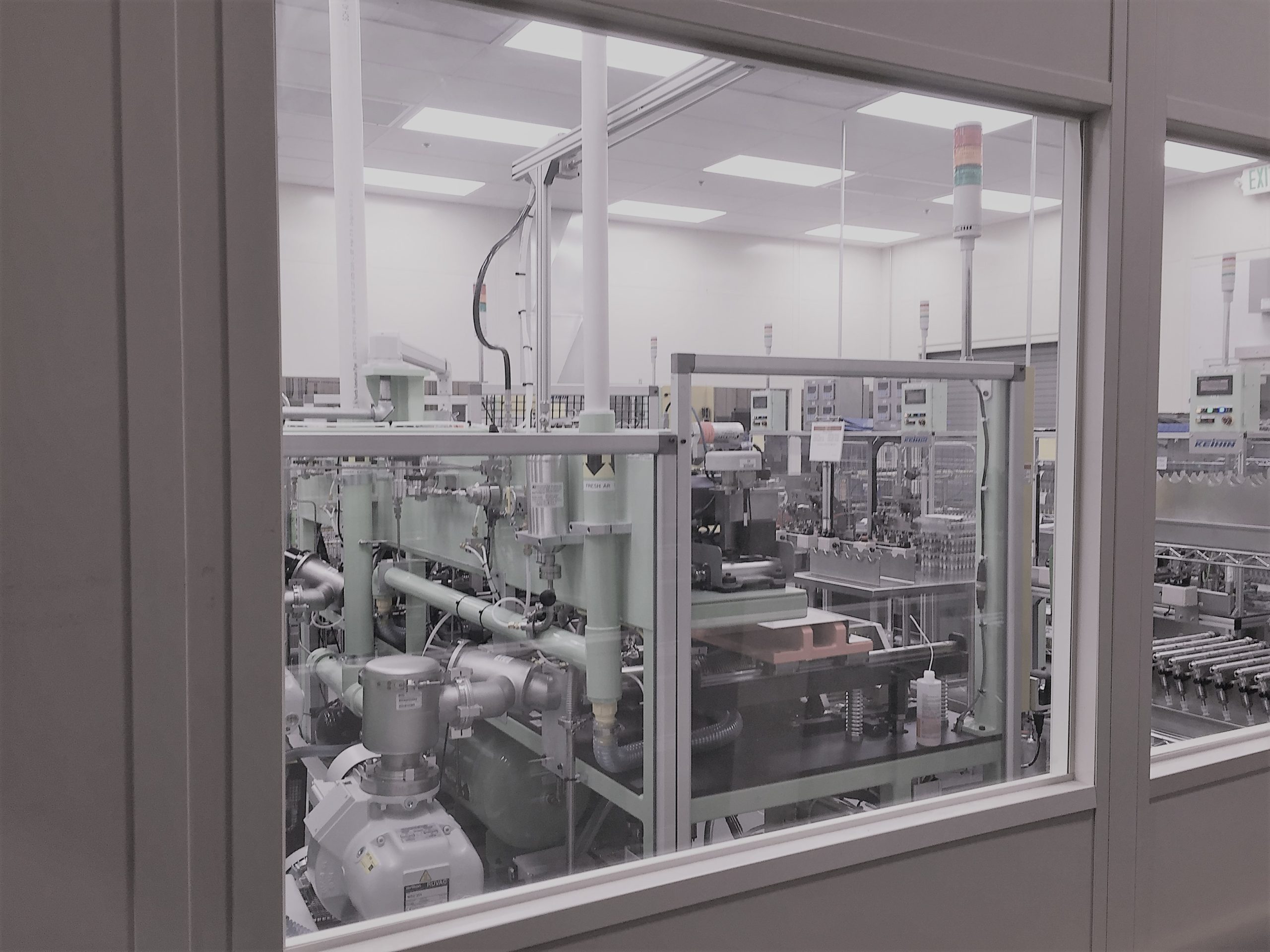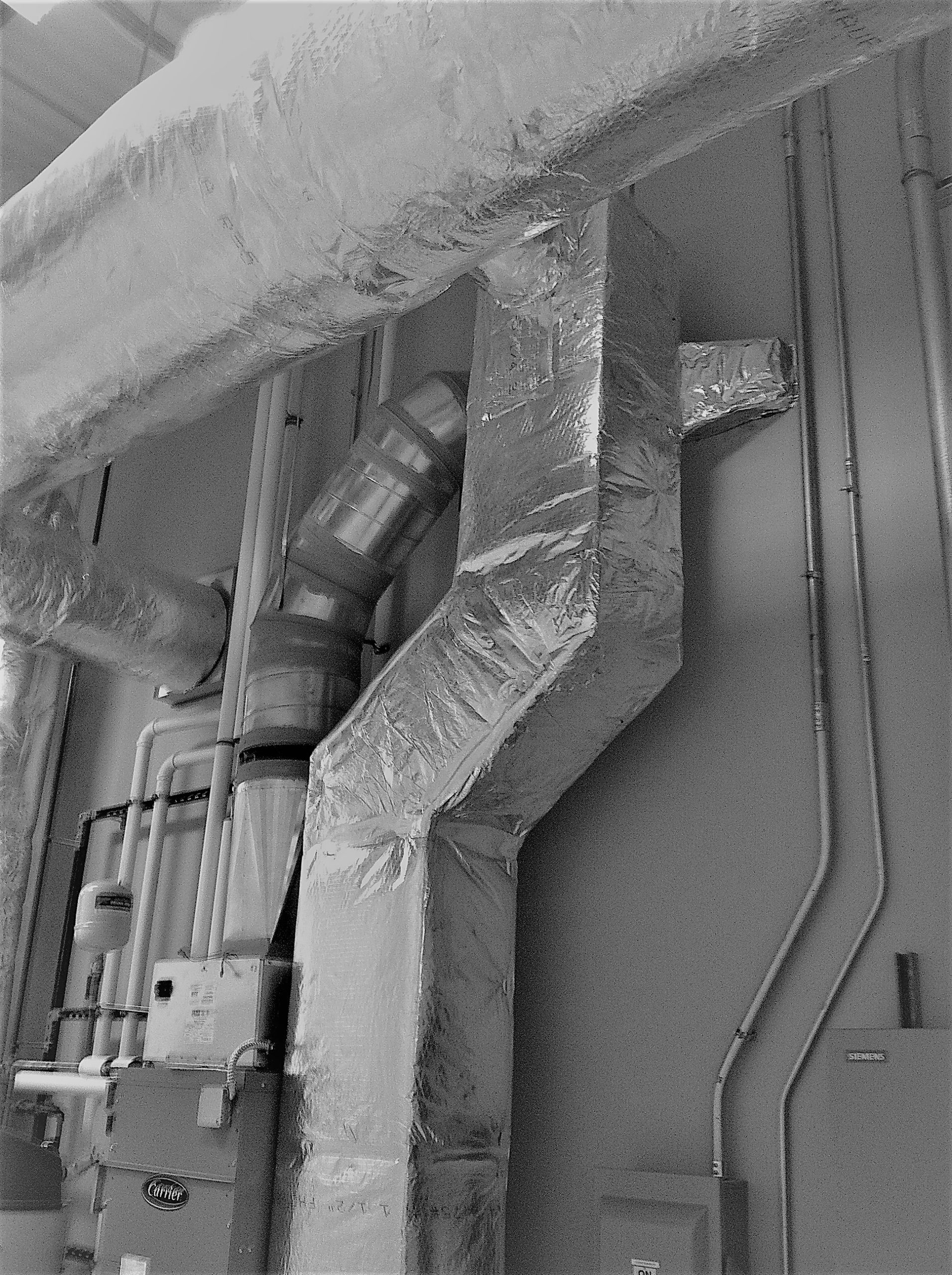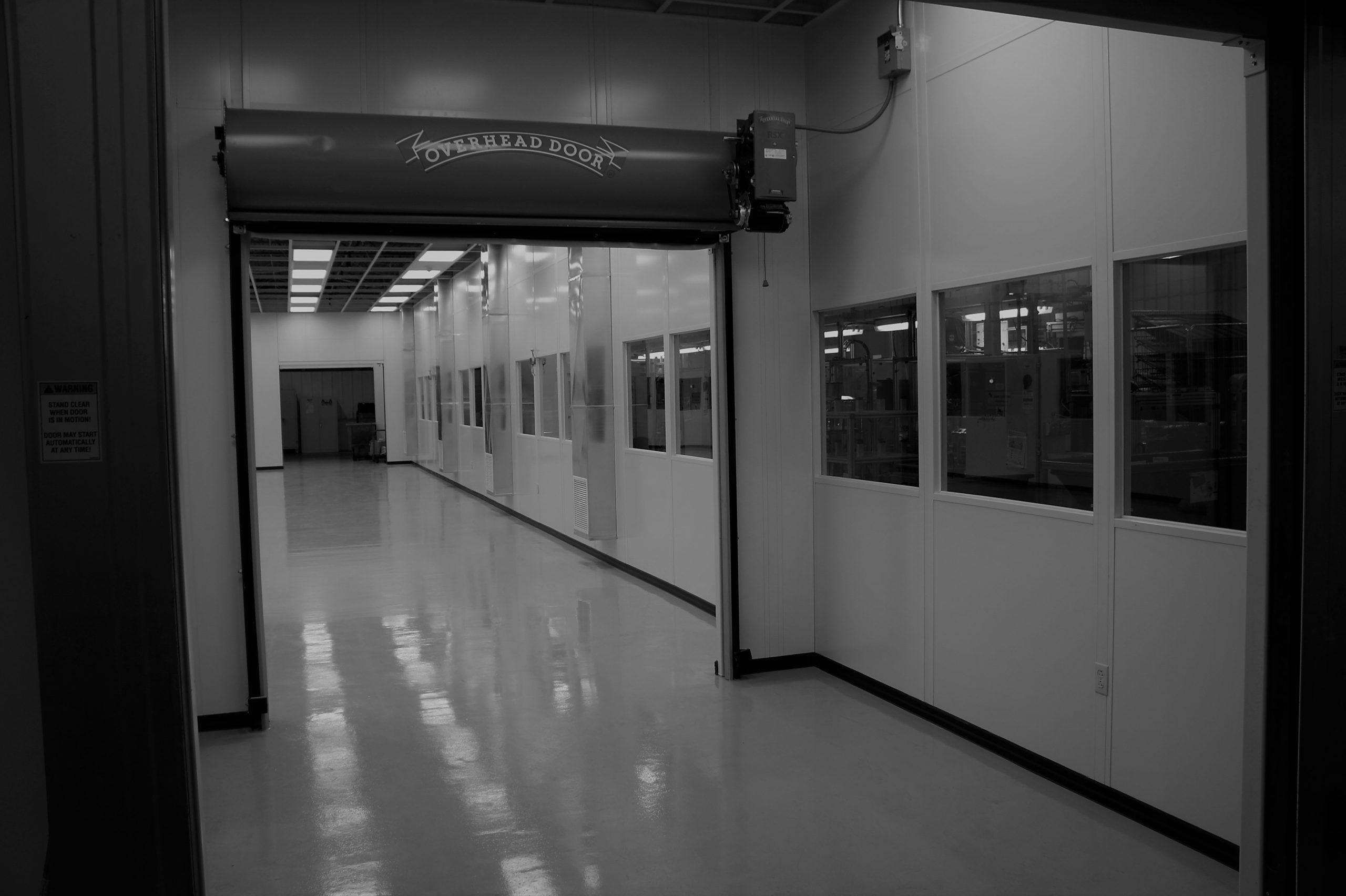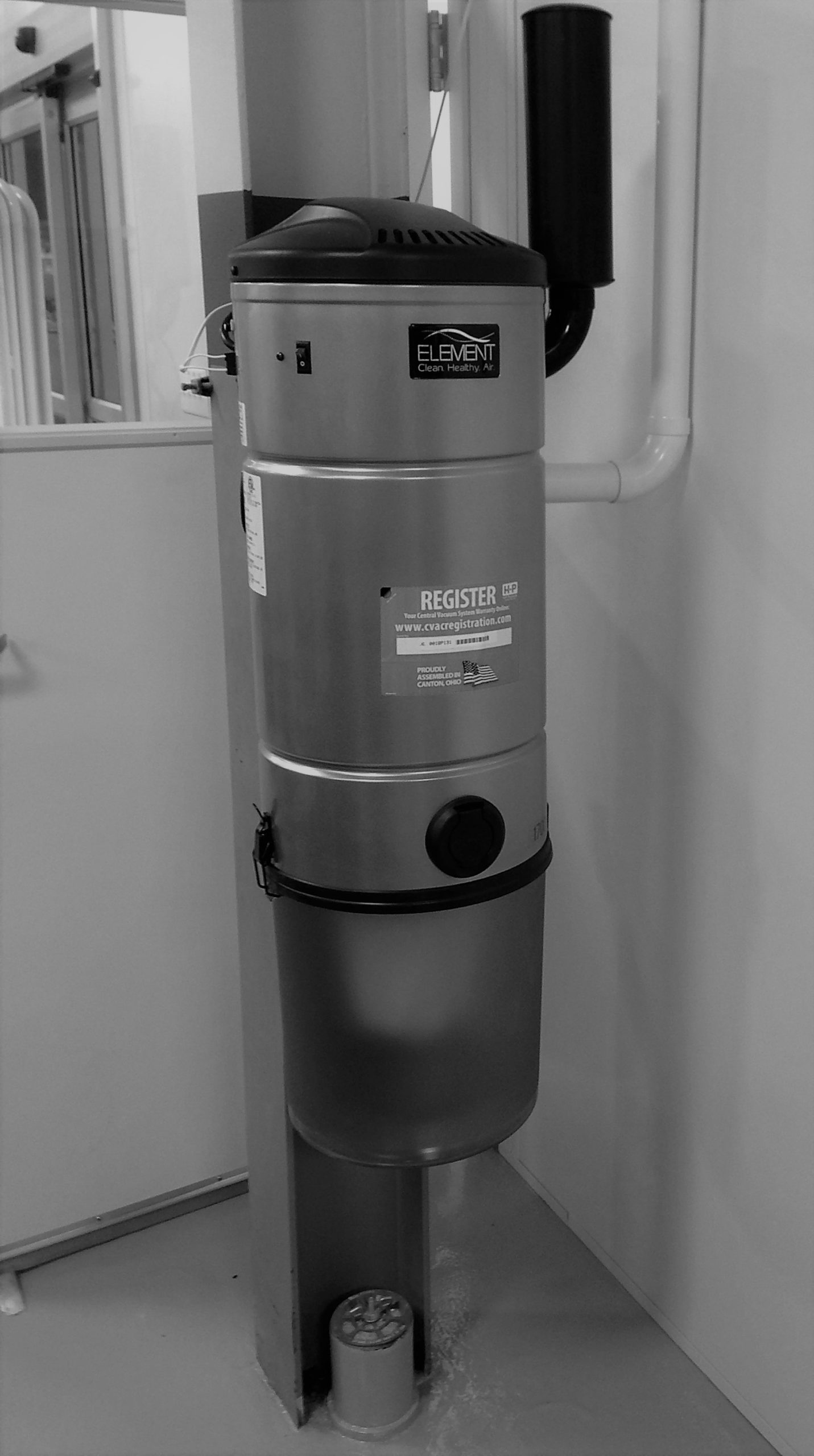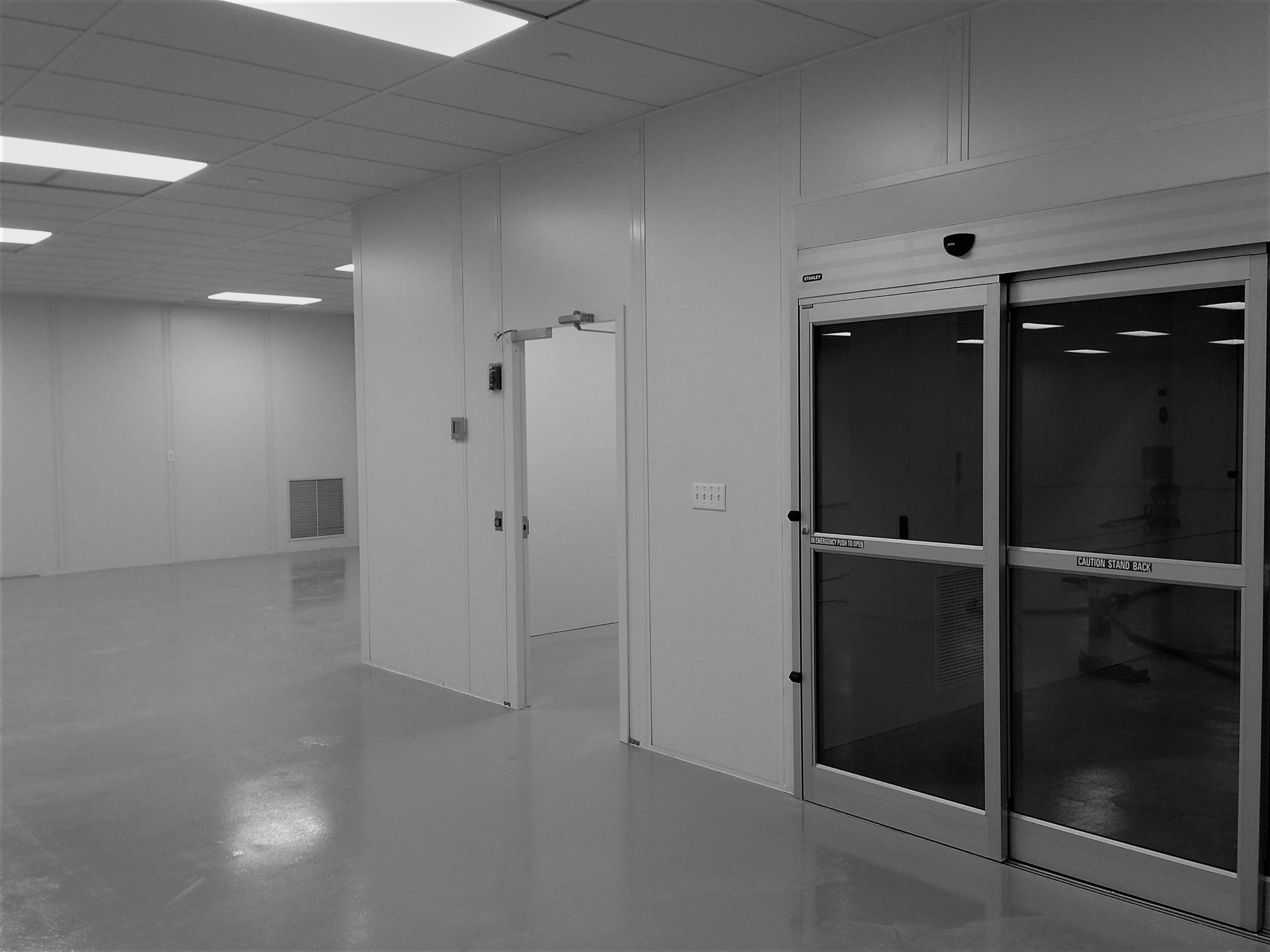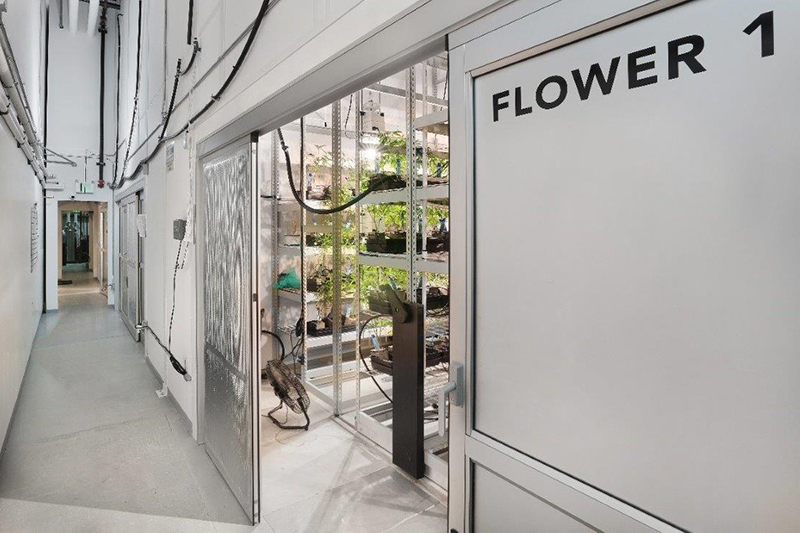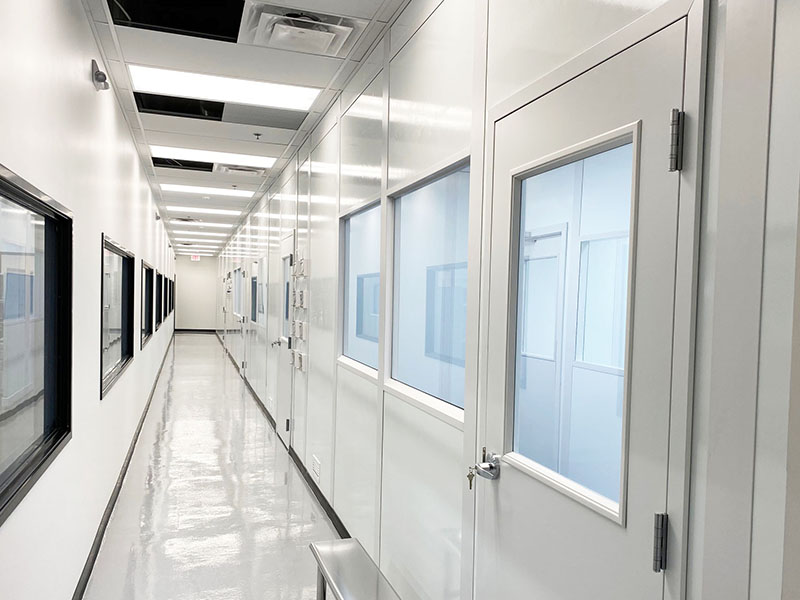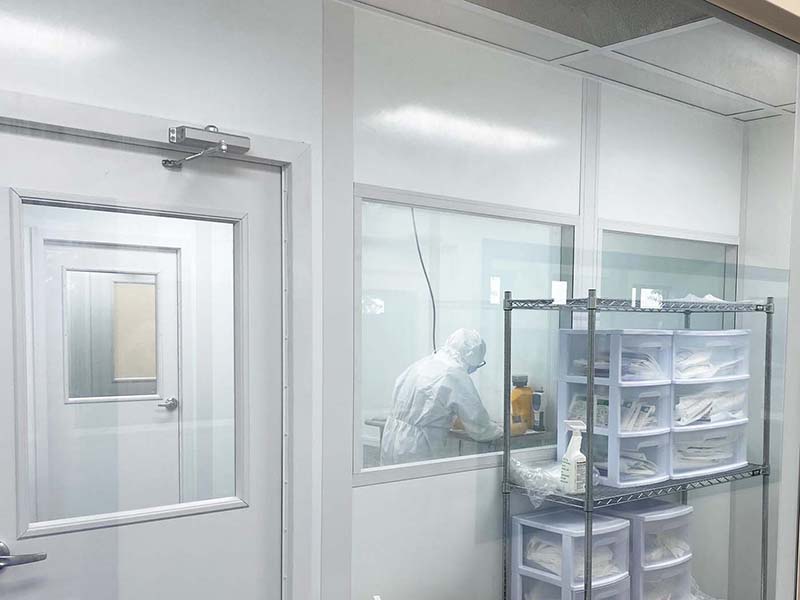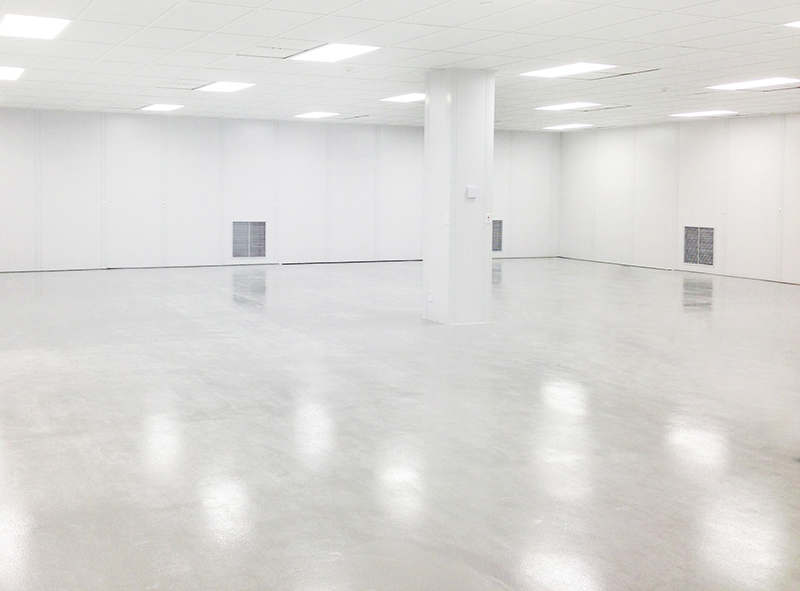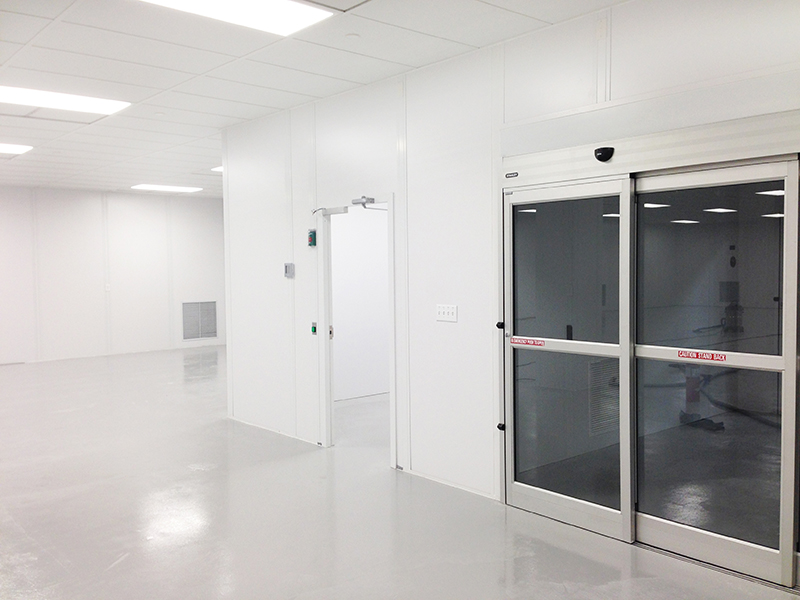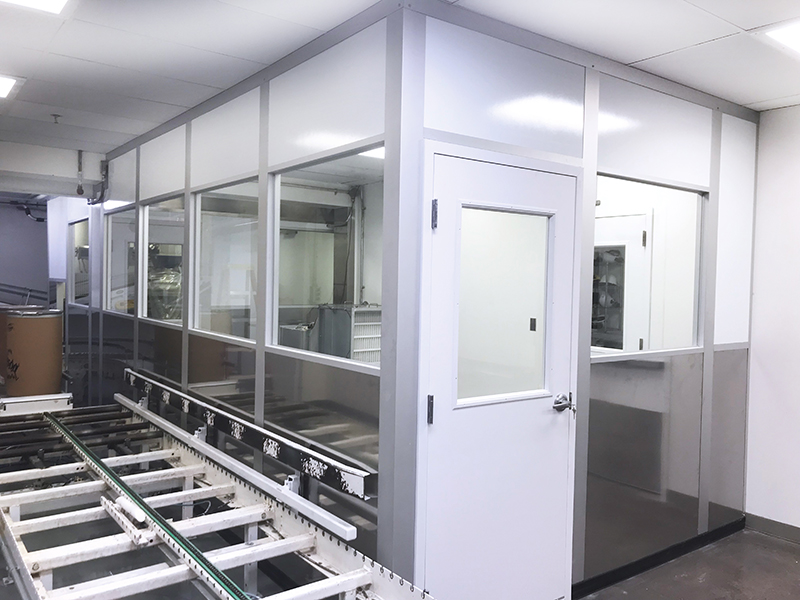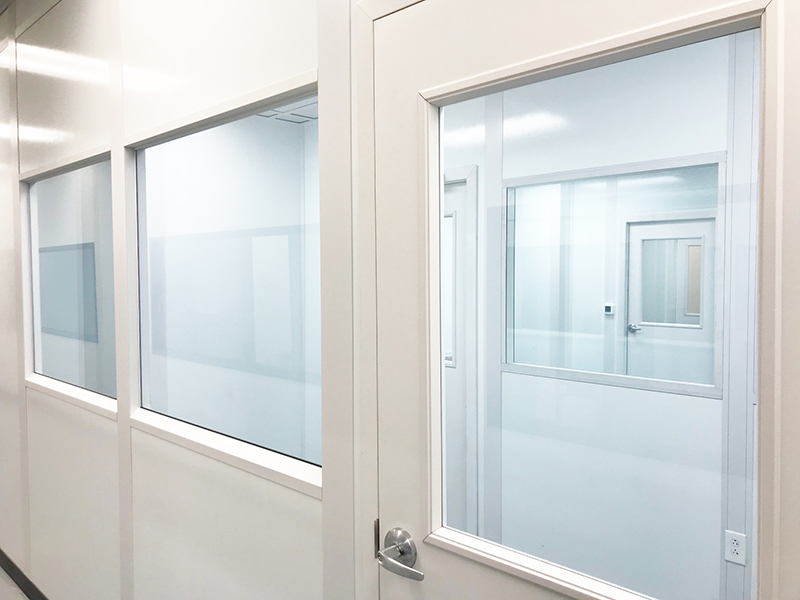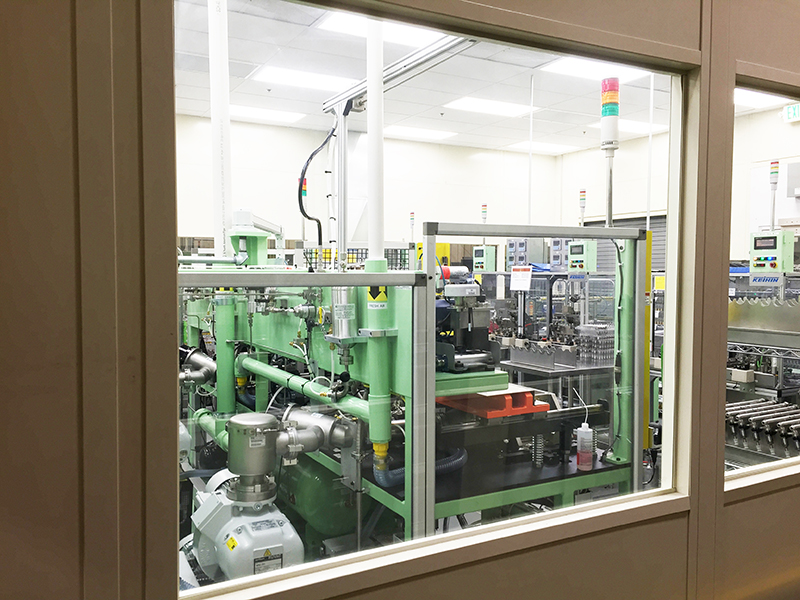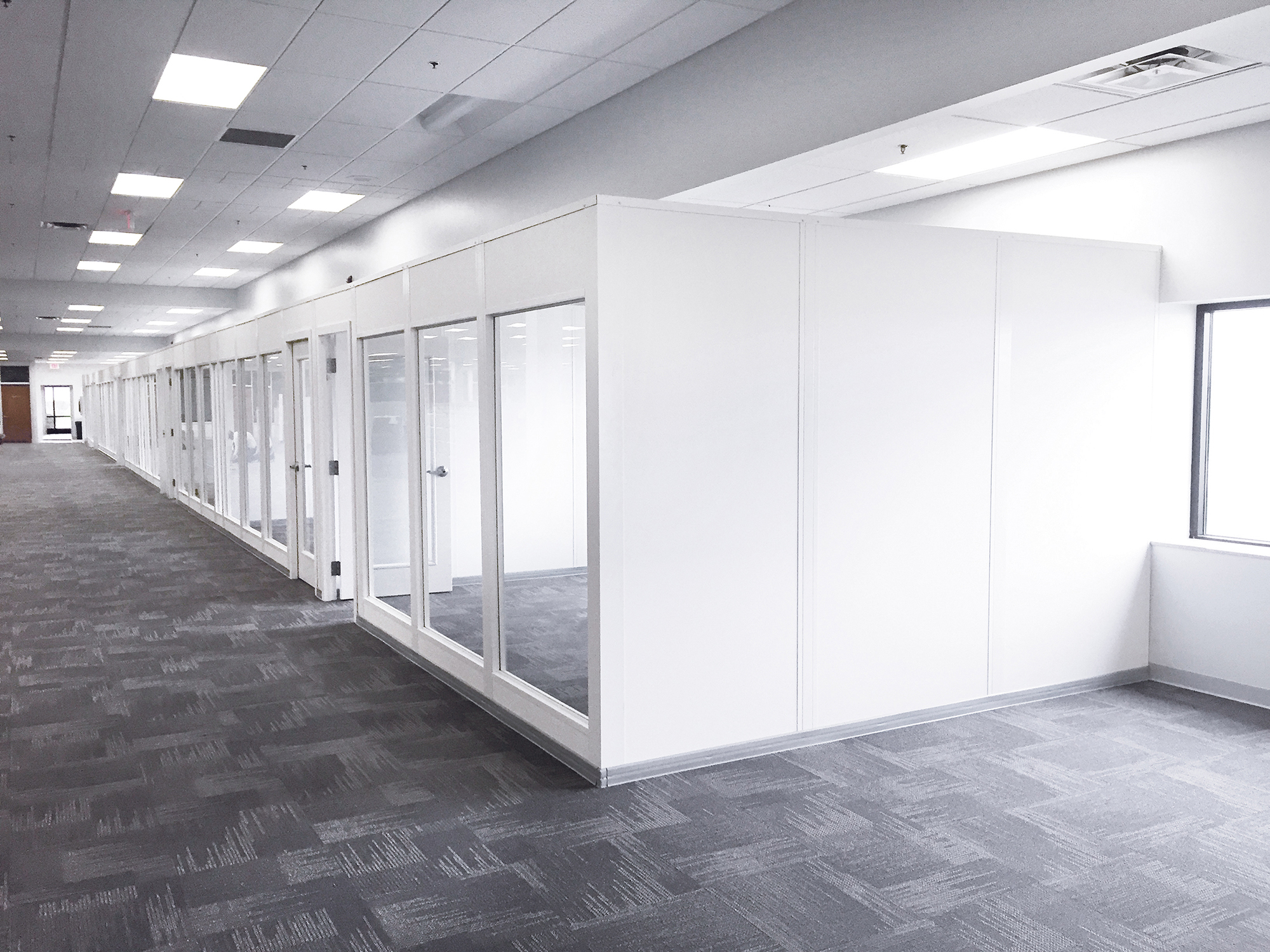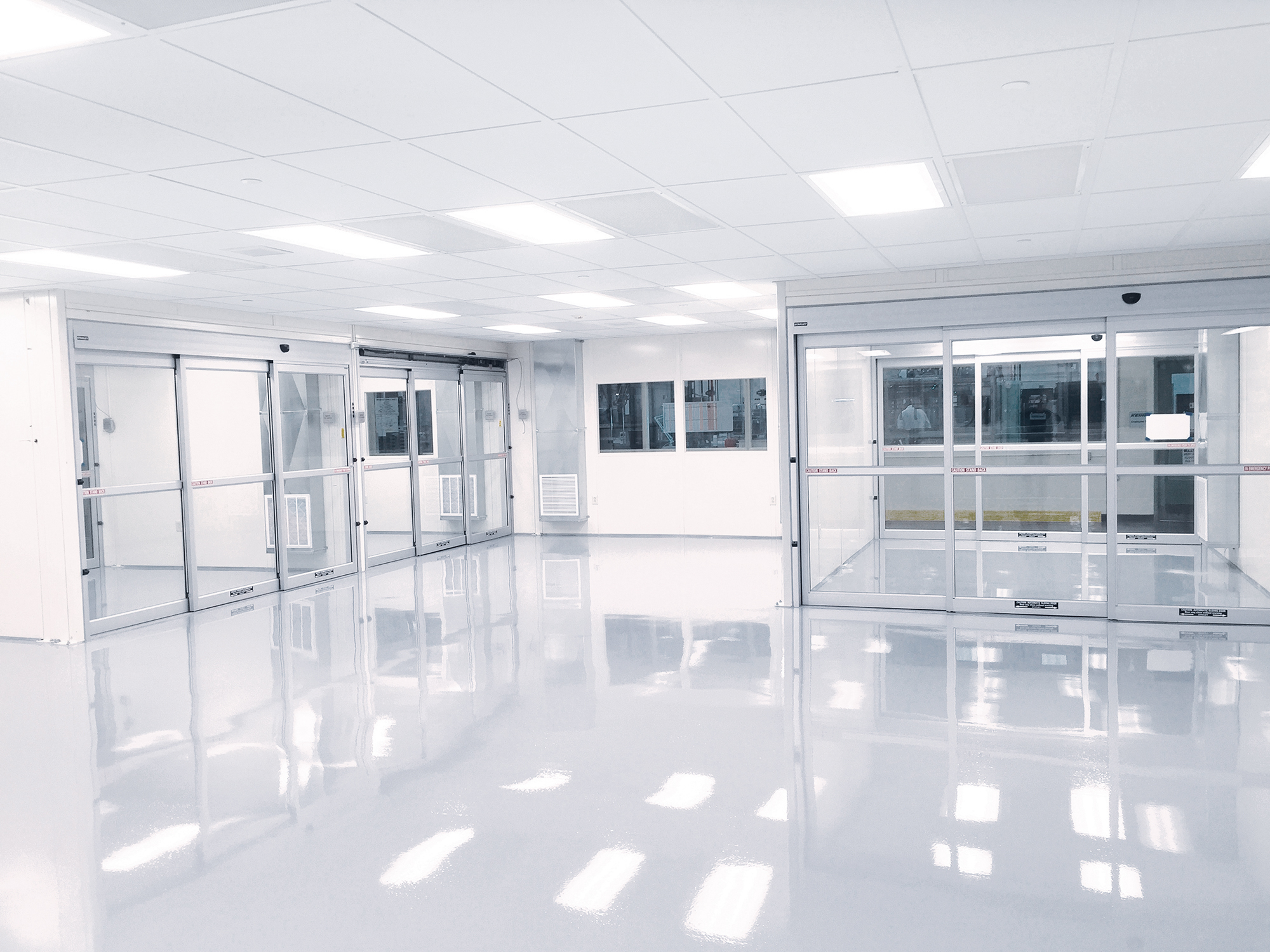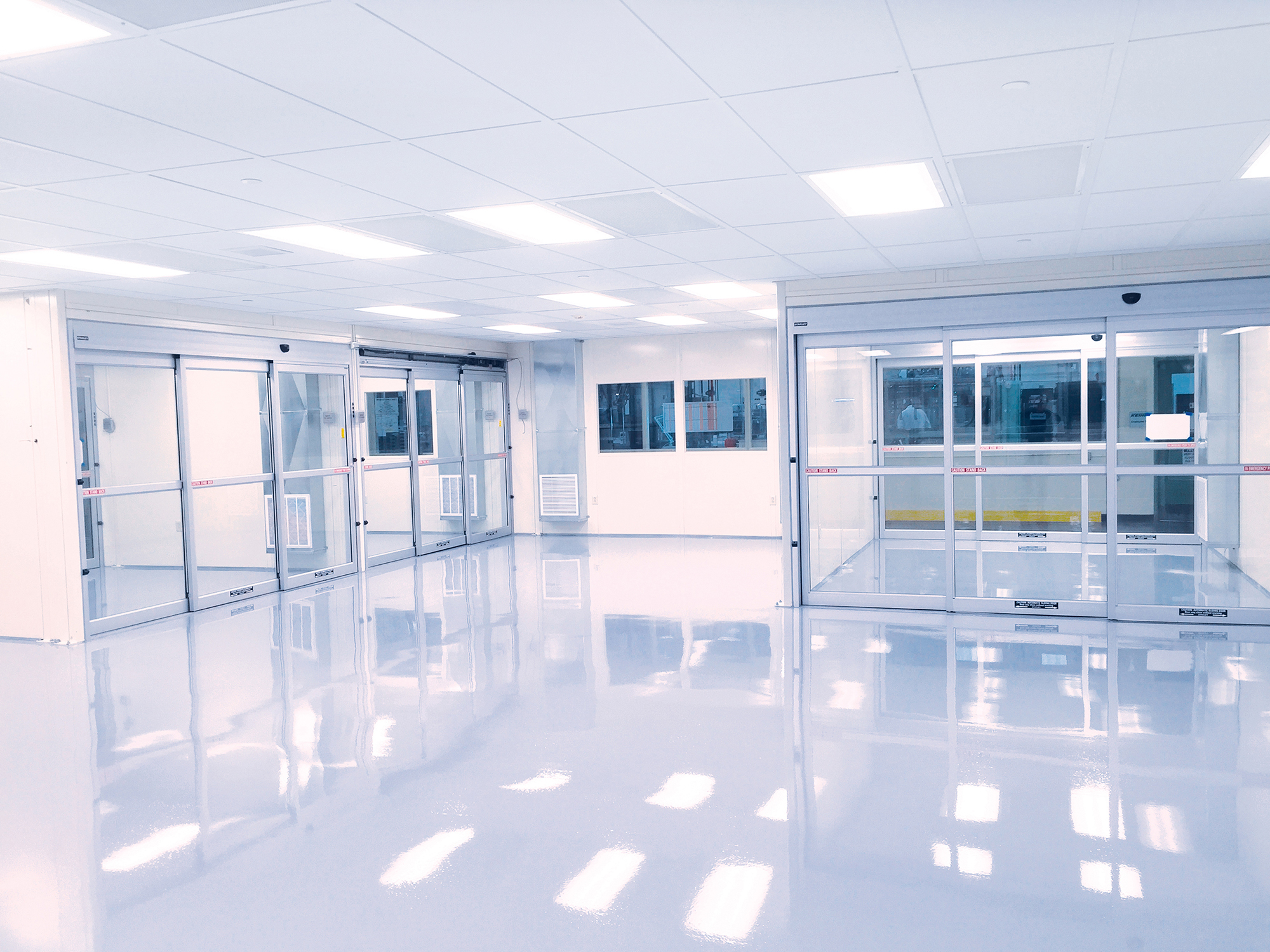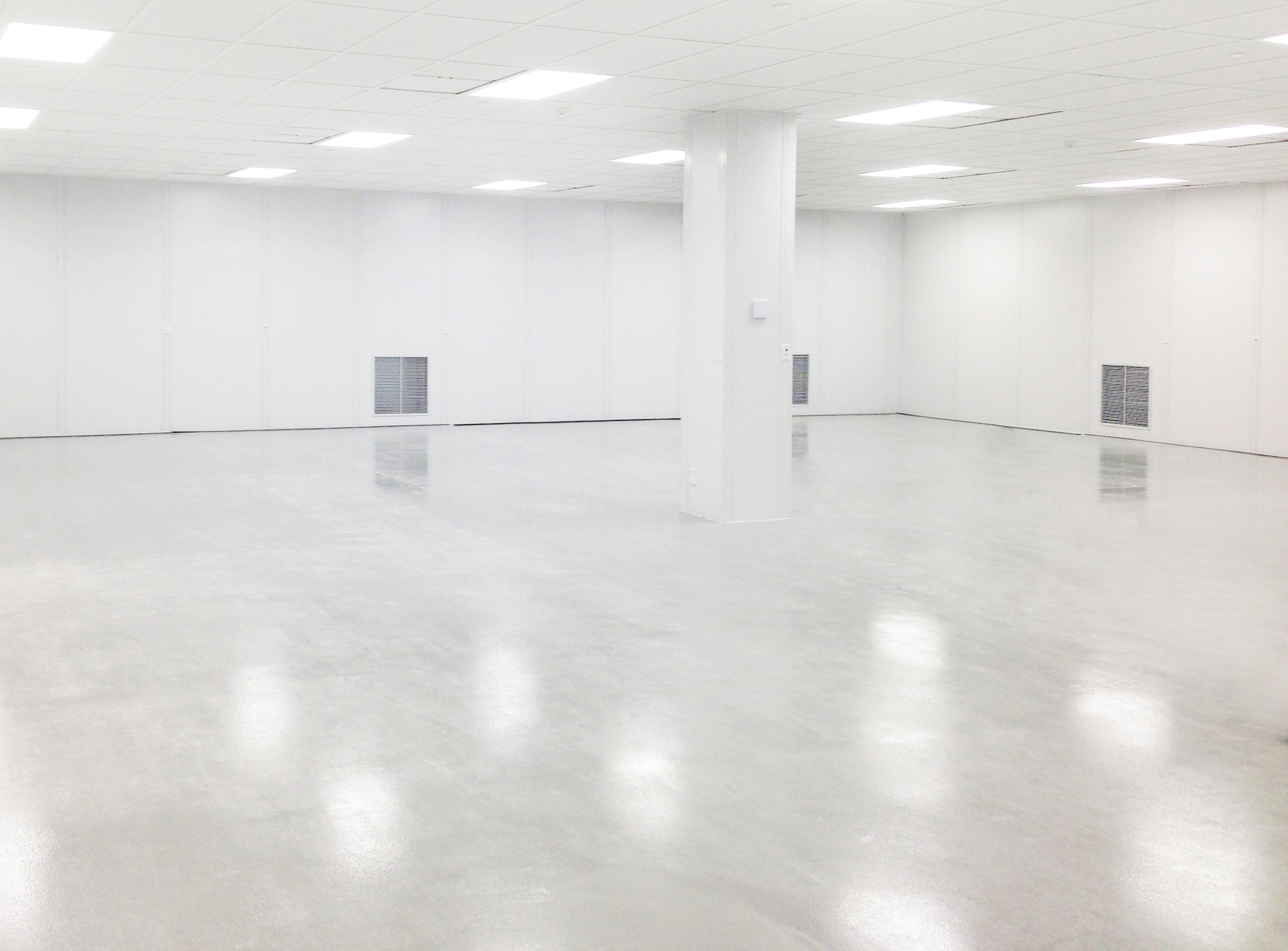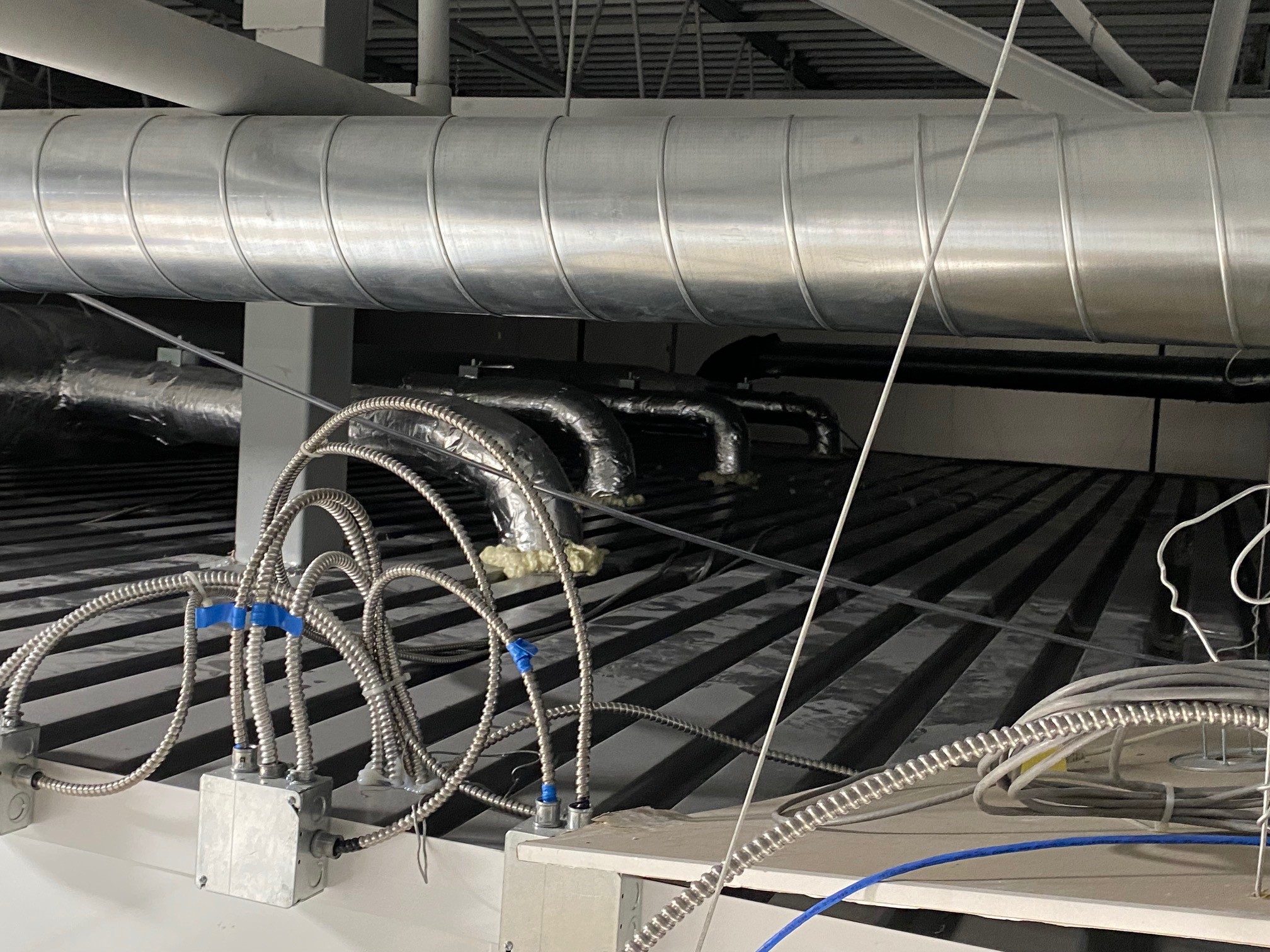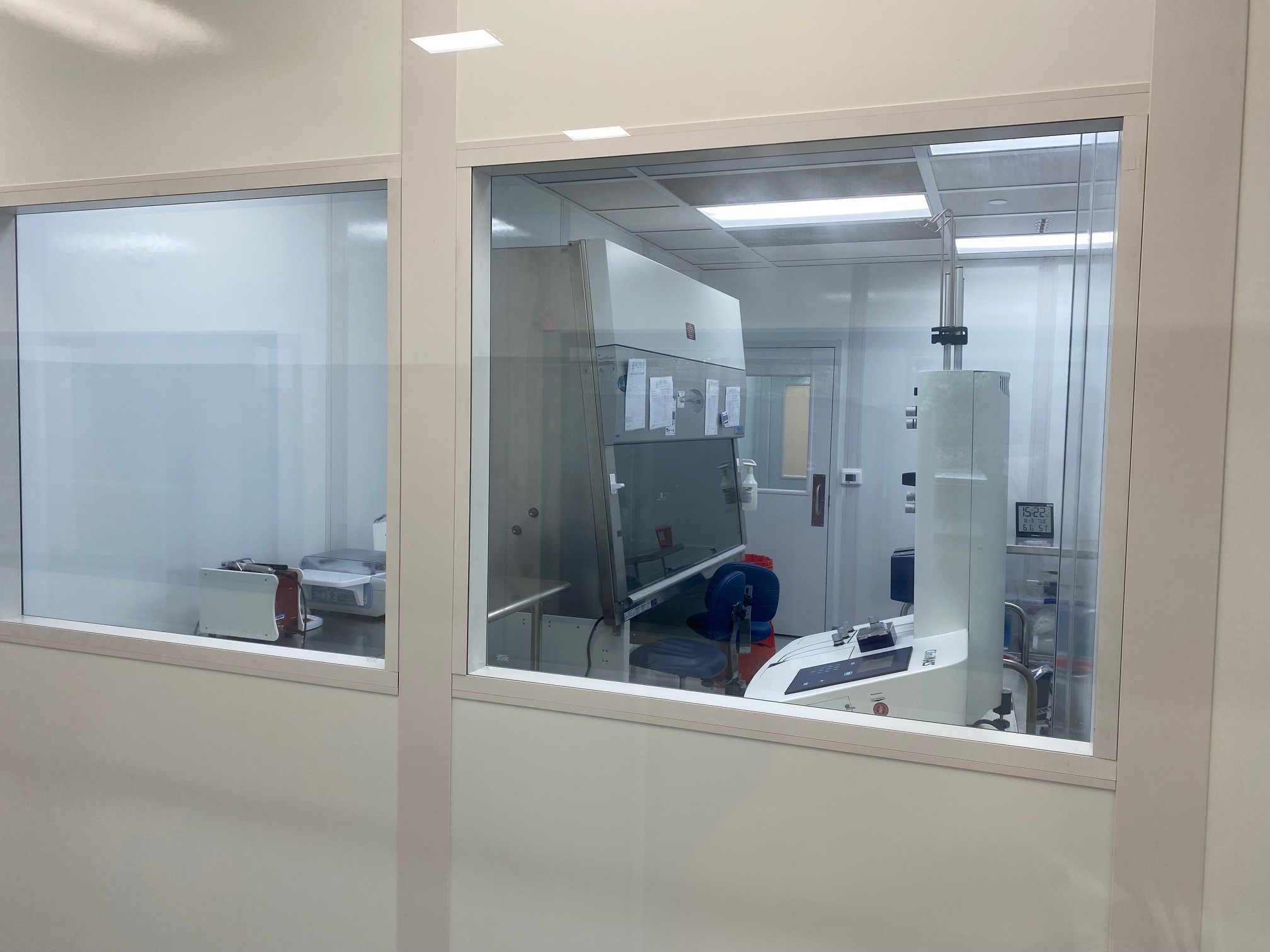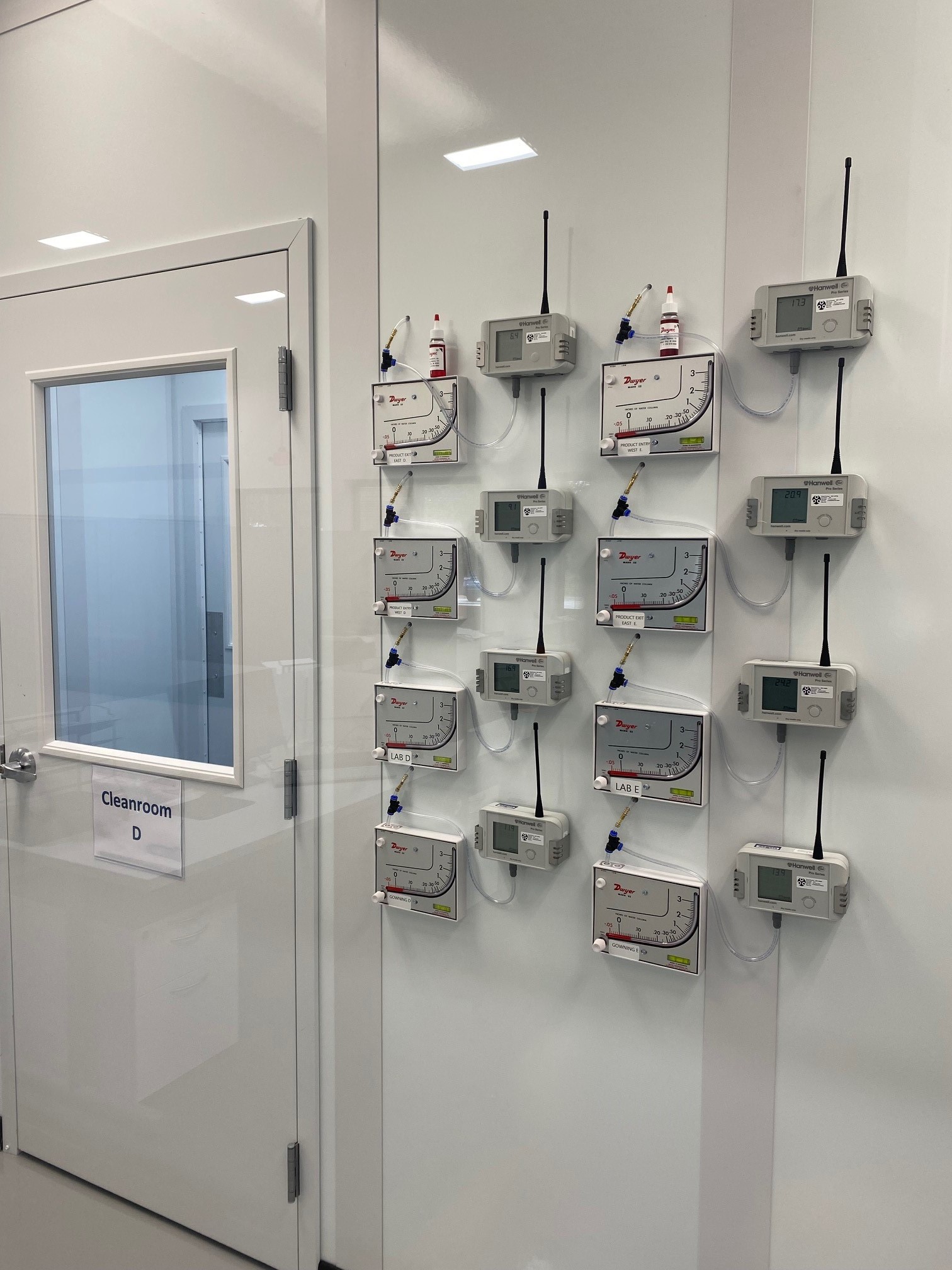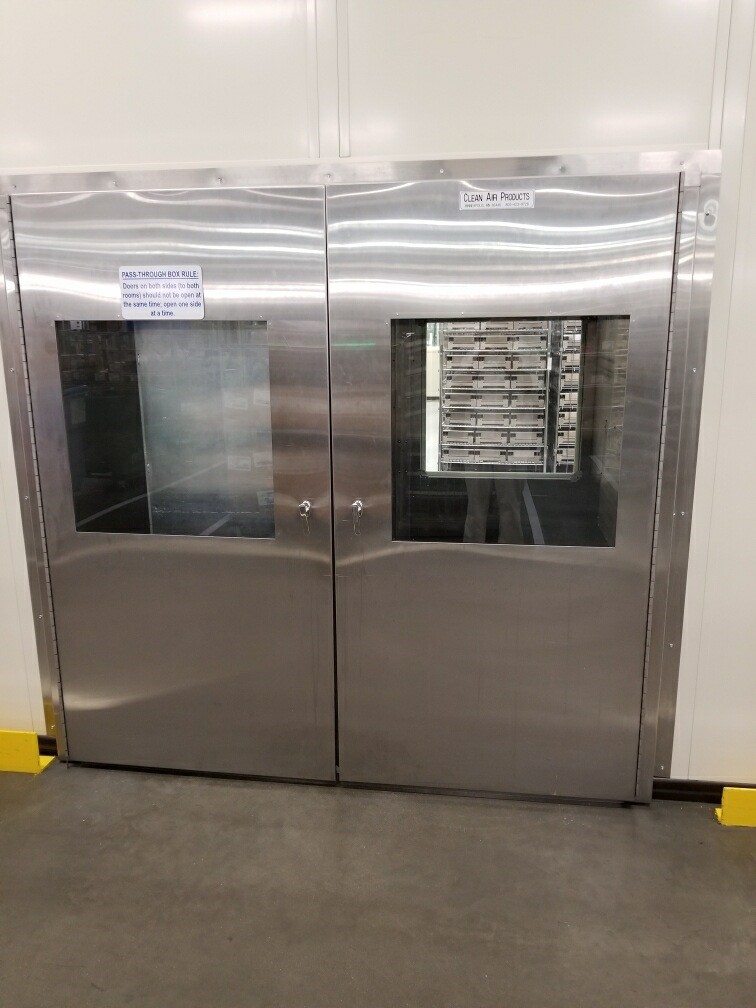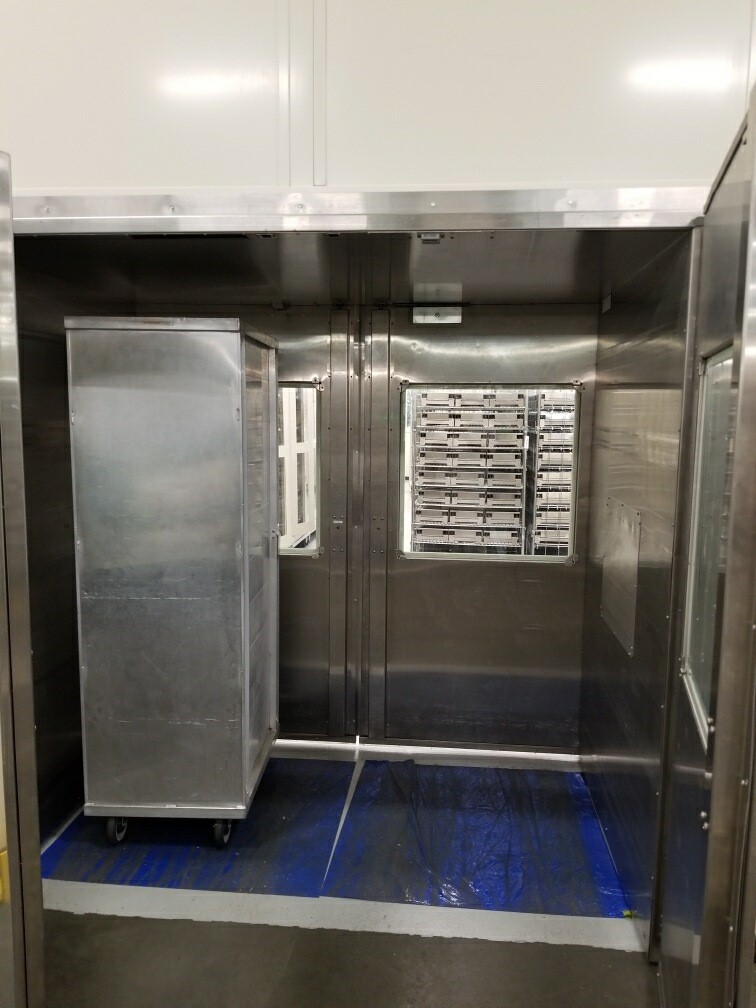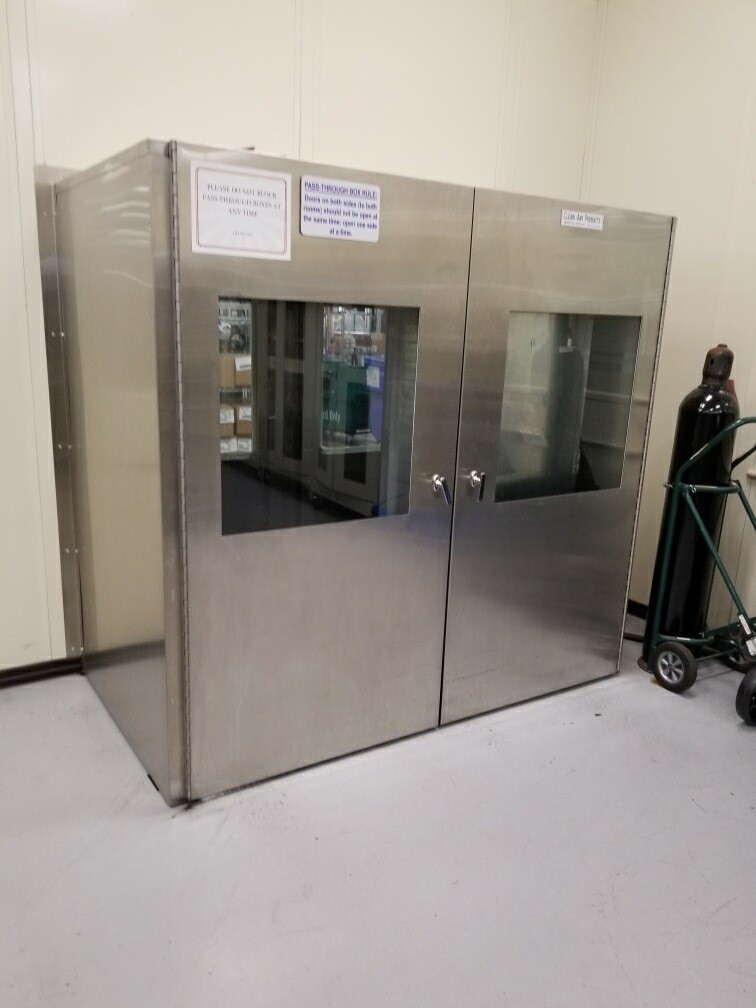Glossary of Terms
AIR CLEANLINESS
Usually measured by taking airborne particle counts with a particle counter. The cleaner the air, the higher class a cleanroom.
AIR CONDITIONING
Particle control, temperature and humidity performance need to be balanced in order to create a clean and repeatable environment. All AC units are mounted into the ducting of the cleanroom and HEPA filters are added to ensure the cleanest air possible.
AIR DIFFERENTIAL
Differential pressure is pressure that is higher or lower than the standard atmospheric pressure. The difference in pressure is used to create natural airflow in the cleanrooms.
AIR HANDLING UNIT (AHU)
Distributes and returns air within a building. They can be used in cleanroom systems but only in certain circumstances.
AIR LOCK
A small room with interlocked doors, constructed to maintain air pressure control between adjoining cleanrooms.
AIR SHOWER
An enclosed entryway usually at the entrance of a cleanroom or between cleanrooms of different ISO ratings. After a worker has dressed in their coveralls, they step through a door into the air shower and upon sealing both entry doors, they are blasted with pressurized air to remove excess particles and dust before entering the clean room.
AIR VELOCITY
The rate of air movement measured in distance travelled relative to time elapsed. Commonly measured in meters per second (m/s) or feet per minute.
AIRBORNE PARTICLE COUNTS
An air sampling method used to determine if a cleanroom is meeting its ISO 14644-1:2015 class parameters. These checks should be done routinely to ensure consistent particle levels.
AIRBORNE PARTICLES
Sub-micron particles that are invisible to the naked eye. For example, a micron is roughly the size of a human hair follicle.
AIRFLOW UNIFORMITY
The consistency of which a stream of air passes over the surface of an object. Measured in volume occupied relative to time elapsed. Commonly measured in cubic meters per second (m3/s), liters per second (L/s), or cubic feet per minute (ft3/min).
ASHRAE
Commonly used acronym for the American Society of Heating, Refrigerating, and Air-Conditioning Engineers.
AS-BUILT CLEANROOM
A cleanroom complete, functional, and ready for operation, but without the equipment and personnel inside. Testing a cleanroom as built reflects the quality of the supply air.
ASEPSIS
A state of control attained by using an aseptic work area and performing activities in a manner that precludes microbiological contamination of the exposed sterile product.
ASEPTIC PROCESSING ROOM
A room where aseptic activities or processes are performed.
AT-REST CLEANROOM
A cleanroom that is complete and ready for operation but has no personnel inside it yet. Testing a cleanroom at-rest allows for smoke testing over critical equipment surfaces to check positioning.
BIO-SAFETY HOOD CLASSIFICATION
Classification used to determine the levels of containment a fume hood will provide regarding potential contamination by hazardous vapors, gases and particles.
CFM
An abbreviation for Cubic Feet per Minute (cu ft/min). When used in the context of a particle counter’s flow rate, it is a measurement of the velocity at which air flows into the sample probe.
CIP
An abbreviation for Clean-in-Place, a method of cleaning the interior surfaces of pipes, vessels, process equipment, filters and associated fittings, without disassembly
CLASS 1-1,00 CLEANROOMS
Classification levels that indicate the acceptable number of particles in a cubic foot of cleanroom space. Class levels are usually determined from the number of 0.5 micron or larger particles per cubic foot.
CLEAN NON-CLASSIFIED AREA
An area that is not required to meet any predetermined grades of cleanliness but still needs to have a level of microbial control.
CLEANROOM
Enclosed room designed to maintain extremely low levels of particulates, such as dust, airborne organisms, or vaporized particles. Cleanrooms typically have a cleanliness level quantified by the number of particles per cubic meter at a predetermined molecule measure.
CLEANROOM APPAREL
Non-shedding apparel that is designed specifically to serve as a barrier between cleanroom environments and possible contaminants released by cleanroom workers.
CLEANROOM CLASSIFICATIONS
System used to determine the acceptable concentration of particles in an identified volume of air. Classification levels are determined by the federal government.
CLEANROOM CONSTRUCTION
A space or system of spaces in which there are tightly controlled limits that govern air flow, air pressure, air filtration, temperature, relative humidity, viability of airborne particles, access, and operating procedures.
CLOSED SYSTEM
A system in which the sterile product is not exposed to the surrounding environment.
COMMISSIONING
Activities to verify that equipment and systems are installed according to specification.
CONTAINMENT
The utilization of filters and controlled ventilation systems in a designated space for capturing and containing potential contaminants.
COVED FLOOR
When the floor is extended at the edges to be applied up the wall, creating a curved surface from wall to floor. Coved floors are the preferred choice for healthcare and medical cleanrooms.
CRITICAL AREA
An area designed to maintain sterility of sterile materials.
CUMULATIVE PARTICLE COUNTS
Particle counters display readings in two columns: cumulative (often depicted by ∑ sigma) and differential (often depicted by ∆ delta).The cumulative total shows the amount of particles that were found at that size and greater. The differential total shows the counts which are at least that size in diameter and up to, but not including the next size.
DE-CENTRALIZED AIR HANDLING
Through a de-centralized air handling approach, the same results can be delivered as with an AHU, but with a significantly reduced installation outlay and running cost. By utilizing several smaller, localized inverter driven temperature control units and ceiling mounted HEPA fan filter units, a level of unrivalled resilience and modularity can be realized. All controlled air is appropriately blended in ducting before introduction into the cleanroom.
DE-IONIZED WATER (DI)
Water that has been purified to a level where its ions have been removed, but not as much as WFI.
DECONTAMINATION
A process that eliminates viable bioburden via use of chemical agents.
DESICCATORS
A sealable enclosure that contains desiccants or nitrogen gas that are used to prevent reactions between moisture-sensitive materials and atmospheric humidity.
DISINFECTION
The process by which surface bioburden is reduced to a safe level or eliminated. Some disinfection agents are effective only against vegetative microbes, while others possess additional capability to effectively kill bacterial and fungal spores.
DOOR INTERLOCK
Interlocked doors support good cleanroom entry and exit practices by only allowing one door to open at a time, preserving integrity. A magnetic lock on each interlocked door with integrated LED lock status indication provides visual feedback on current door status. With stainless steel infrared touchless proximity switches, activated by close proximity of the hand, there is no need to touch making them ideal for clean environments.
ELECTROSTATIC DISCHARGE (ESD)
The transfer of electric charge between two surfaces as a result of friction.
EMA
European Medicines Agency. European Union agencies network.
ESD HARD WALL CLEANROOM PANELS
For cleanroom environments where electrostatic charge is a process risk, static dissipative clear panels are recommended. Panels should feature a conductive static dissipative surface coating on both sides.
FAN FILTER UNIT (FFU)
A fan filter unit is a motorized unit which supplies clean, filtered air to a cleanroom.
FDA – Food and Drug Administration
The Food and Drug Administration (FDA or USFDA) is a federal agency of the United States Department of Health and Human Services, one of the United States federal executive departments. The FDA is responsible for protecting and promoting public health through the control and supervision of food safety, tobacco products, dietary supplements, prescription and over-the-counter pharmaceutical drugs (medications), vaccines, biopharmaceuticals, blood transfusions, medical devices, electromagnetic radiation emitting devices (ERED), cosmetics, animal foods & feed[4] and veterinary products.
FEDERAL STANDARDS FOR CLEANROOMS
The U.S. Federal Standard 209E Cleanroom Standards were the U.S. General Service Administration’s standards. This cleanroom classification system was adopted globally, before the ISO system was developed. Although ISO 14644-1 was introduced in 2001, the Federal Standard 209E is still referenced to this day by industry stalwarts.
FILLING ZONE
A high-risk area in pharmaceutical manufacture, for sterile filling.
FILTER INTEGRITY TESTING
Dispersed Oil Particulate (DOP) testing, also known as filter integrity testing, is the process in which the integrity of your HEPA (High Efficiency Particulate Air) or ULPA (Ultra Low Penetration Air) filter is challenged through introducing particulates and measuring the output.
FLOW RATE
The flow rate of a particle counter is the speed in which air is drawn through the sample probe. For example, a flow rate of 0.1 CFM means the particle counter will sample 0.1 cubic feet of air per minute.
FUNCTIONAL DESIGN SPECIFICATION (FDS)
Specification in which the demands of the manufacturer are transferred into a technical solution (from the Manufacturer ‘s point of view). Also known as Functional Specification (FS).
FUME HOODS
Cabinet that has in air flow thus protecting operator from dangerous or noxious vapors or particles.
FUNCTIONAL REQUIREMENT SPECIFICATION (FRS)
Definition of requirements to fulfil the demands of the process (from the Users point of view).
GLOVEBOX
Controlled enclosure that incorporates sealed gloves into the design, allowing for manual control of High Efficiency Particulate Air (HEPA) filter that is constructed using materials that can withstand temperatures up to 400°C, providing filtration for cleanroom and laboratory ovens. High temperature filters use stainless steel or aluminum for the frame and silicone or glass for the gasket.
GMP GUIDELINES
Good manufacturing practice (GMP) is the minimum standard that a medicines manufacturer must meet in their production processes.
GOOD AUTOMATED MANUFACTURING PRACTICE (GAMP)
A guide for the validation of automated systems in pharmaceutical manufacture.
GOWNING PROTOCOLS
Contrary to safety PPE, clothing worn in cleanrooms acts to protect the environment from the wearer.
GRADE 316 STAINLESS STEEL
Approximate Composition – 17% chromium, 10% nickel, 2% molybdenum (exact composition ranges vary between EN and ASTM standards). Molybdenum enhances the corrosion resistance of stainless steel even in relatively small amounts. 1% of molybdenum is worth about 3% of chromium in terms of corrosion resistance. In environments where 304 (1.4301) is found to be inadequate (i.e. due to harsh cleaning chemicals), 316 (1.4401) is the natural first grade to be considered.
HARDWALL CLEANROOM
Prefabricated room that has rigid walls and constructed to meet stringent cleanroom requirements. Hardwall cleanrooms may be incorporated into existing structures or may stand alone. The proper coating or paint need to be applied as to not outgas create any particles. Can be single pass or re-circulating air. Hardwall cleanrooms can sustain positive pressure. Can be ISO 3-8.
HEPA FILTER
A High Efficiency Particulate Air (HEPA) filter that meets specific regulations for interception, impaction, and diffusion of airborne particulates.
HEPA FILTER MODULE
High Efficiency Particulate Air (HEPA) filter that is integrated into a disposable housing for use in cleanroom ceiling installations. HEPA filter modules are usually available in fan-assisted and non-fan-assisted variations.
HEPA FILTRATION
A HEPA filter is a filter media which is efficient at removing submicron particles from the air.
HEPA HIGH TEMPERATURE
High Efficiency Particulate Air (HEPA) filter that is constructed using materials that can withstand temperatures up to 400°C, providing filtration for cleanroom and laboratory ovens. High temperature filters use stainless steel or aluminum for the frame and silicone or glass for the gasket.
HUMIDITY CONTROL
Regulation of the degree of saturation (relative humidity) or quantity (absolute humidity) of water vapor in a mixture of air and water vapor.
HVAC
HVAC is an acronym for Heating, Ventilation and Air Conditioning, so it relates to air handling.
INTEGRAL BENCHING
For optimum space utilization, integrated benching can be installed in cleanrooms.
ISO CLEANROOM CLASSIFICATIONS
Cleanroom air cleanliness classifications that provide standards for the identification, control, and monitoring of various airborne particles and contaminants.
LAMINAR AIR FLOW
Air stream that flows through a HEPA filter and moves with uniform velocity within a confined space. Alternately referred to as “unidirectional flow”, laminar air flow generally moves along parallel flow lines.
LAMINAR FLOW CABINETS
Vertical laminar flow cabinets / booths create either a localized clean environment or additional protection for critical processes within an existing controlled environment.
LED LIGHTING
LED light fittings can be optimized to support minimum working plane Lux requirements.
LOW LEVEL EXHAUST VENT
A low-level exhaust vent is an outlet at the bottom of a cleanroom where particles are flushed out due to the positive airflow and pressure differential. A full perimeter exhaust vent will allow an even airflow.
LUX LEVELS
Lux is a measurement of light and getting the required lux levels right is a crucial step for the safe and effective operation within the controlled environment. Typically, the minimum lux requirements for a cleanroom are driven by the production of small and sensitive components. The lighting levels then need to be high enough so that processes are properly illuminated.
MAGNEHELIC PRESSURE GAUGE
Magnehelic differential pressure gauges are provided to ensure a positive pressure boundary is maintained to less controlled areas.
MICRON
Unit of measurement for miniscule length equal to one-millionth of a meter or 0.00003937 inch. Expressed as µm and alternately referred to as a micrometer.
MODULAR CLEANROOM
Versatile engineered and prefabricated cleanroom units that are manufactured with self-contained ventilation and electrical systems that comply with industry standards. These are usually prefabricated in a manufacturing plant and assembled on site. These can be disassembled, relocated and reassembled at any time.
OCCUPANCY STATES
As-built – condition where the cleanroom or clean zone is complete with all services connected and functioning but with no equipment, furniture, materials or personnel present
At-rest – condition where the cleanroom or clean zone is complete with equipment installed and operating in a manner agreed upon, but with no personnel present
Operational – agreed condition where the cleanroom or clean zone is functioning in the specified manner, with equipment operating and with the specified number of personnel present.
OPERATIONAL CLEANROOM
A cleanroom that is complete, functional and ready for operation, with the equipment and personnel inside. Testing a cleanroom operational, allows for an accurate state of play to be observed.
OPERATOR
Any individual participating in the aseptic processing operation, including line set-up, filler, maintenance, or other personnel associated with aseptic line activities.
OQ – OPERATIONAL QUALIFICATION FOR CLEANROOMS
Verify that the cleanroom equipment is achieving the operational parameters specified.
PANEL FILTER
Single- or double-layer filter that is either disposable or can be modified with replaceable filtration material. Most panel filters have a shallow profile with a thickness between 25-100 mm.
PARTICLE COUNTER
Device that measures the size and quantity of particles per cubic air volume. Used to determine the cleanliness rating of a cleanroom.
PARTICULATES
Miniscule segments of manmade or natural matter that has been suspended in gas or liquid.
PASS THROUGH
A small room with interlocked doors, constructed to maintain air pressure control between adjoining rooms (generally with different air cleanliness standards). The intent of an aseptic processing airlock is to preclude ingress of particulate matter and microorganism contamination from a lesser controlled area.
PLENUM
A chamber of air between the outer walls and inner walls or roof deck and the ceiling of a cleanroom, where air is recirculated to go back into the HEPA or ULPA filters.
PREFILTER
Specialized filter that is designed to work with a downstream filter to guard against contamination from large dust particles.
PQ – PERFORMANCE QUALIFICATION
Challenge that the cleanroom equipment is performing together in an operational state.
PRESSURE CASCADE
Pressure cascades with a cleanroom environment ensure that the flow of contamination is from clean to less clean. They are created by using airflow to create pressure differentials between any zones, which ensure that contamination flows from the cleanest zone down. Pressure management is critical to the effective performance of a cleanroom, keeping contamination from reaching the critical process environment.
PRESSURE DIFFERENTIAL
A pressure differential is a difference of pressure between points in a process system. Within the cleanroom industry, they are used to create pressure cascades to control the flow of contamination. See Pressure Cascade.
QUALIFICATION
Establishing documented evidence that provides a high degree of assurance that equipment or facilities will perform to the required specification detailed in the user requirement specification and the design qualification.
RAPID ROLLER DOOR
Rapid roll doors are effective at providing a large opening into a cleanroom for goods in/out. Cleanroom compatible doors require limited space and are ideal for interlocks. The superior and tight seal of this cleanroom roll up door keeps contaminants out and prevents leak flow.
SANITATION
The documented written program of cleaning and disinfecting the cleanroom surface.
SINGLE USE SYSTEMS (SUS)
Systems in which some product contact components are used only once (i.e. single use components) to replace reusable equipment such as stainless-steel transfer lines or bulk containers. SUS covered in this document are those that are used in manufacturing processes of sterile medicinal products (e.g. sterile API, sterile bio bulk, sterile finish dosage), and are typically made up of components such as bags, filters, tubing, connectors, storage bottles and sensors.
STATIC ELECTRICITY
Static electricity is a form of electricity at rest caused by an imbalance at a molecular level within a material.
STICKY MAT
Floor mats which remove contaminates from shoes or wheels as they contact its sticky surface. Sticky mats come in a permanent washable option or as disposable peel-off mats consisting of multiple layers of tacky plastic film which are peeled off as they get dirty. Available in multiple sizes and colors.
TEMPERATURE & HUMIDITY CONTROL
Particle control and temperature and humidity performance need to be balanced in order to create a repeatable environment. Cleanroom performance can be delivered from a cleanroom air conditioning system based on localized AC units. All controlled air needs to be appropriately blended in the ducting before introduction into the cleanroom through ceiling mounted HEPA fan filter units, to ensure temperature and humidity and cleanliness levels are met.
TURBULENT FLOW
Filtered air that is constantly moving around the cleanroom, allowing for no stagnant air.
ULPA FILTRATION
Commonly used acronym for an Ultra-Low Particulate Air filter which has an efficiency rating of 99.9995 on 0.12 micron particles. Usually used to create class 10 (ISO 4) or class 1 (ISO 3) cleanrooms.
UNIDIRECTIONAL FLOW CLEANROOM / LAMINAR FLOW CLEANROOM
Air stream that flows through a HEPA filter and moves with uniform velocity within a confined space. Air flow in a unidirectional flow cleanroom generally moves along parallel flow lines.
USER REQUIREMENT SPECIFICATION (URS)
Definition of requirements to fulfil the demands of the process (from the Users’ point of view).
UV LIGHTING
To supplement standard cleanroom lighting, UV lamps and UV light equipment can be used for both inspection and disinfection processes.
VALIDATION
Procedures for the monitoring and documentation of compliance to specified regulations for the design, construction and performance for a clean manufacturing facility.
VAPORIZED HYDROGEN PEROXIDE (VHP)
Vaporized hydrogen peroxide (VHP) has antimicrobial properties and so has decontamination and sterilization applications, with an added benefit of working at low temperatures. With a wide kill spectrum that includes bacteria, spores, fungi and viruses, VHP decontamination chambers can be preferred to autoclave as they put less pressure on products and use less energy.

